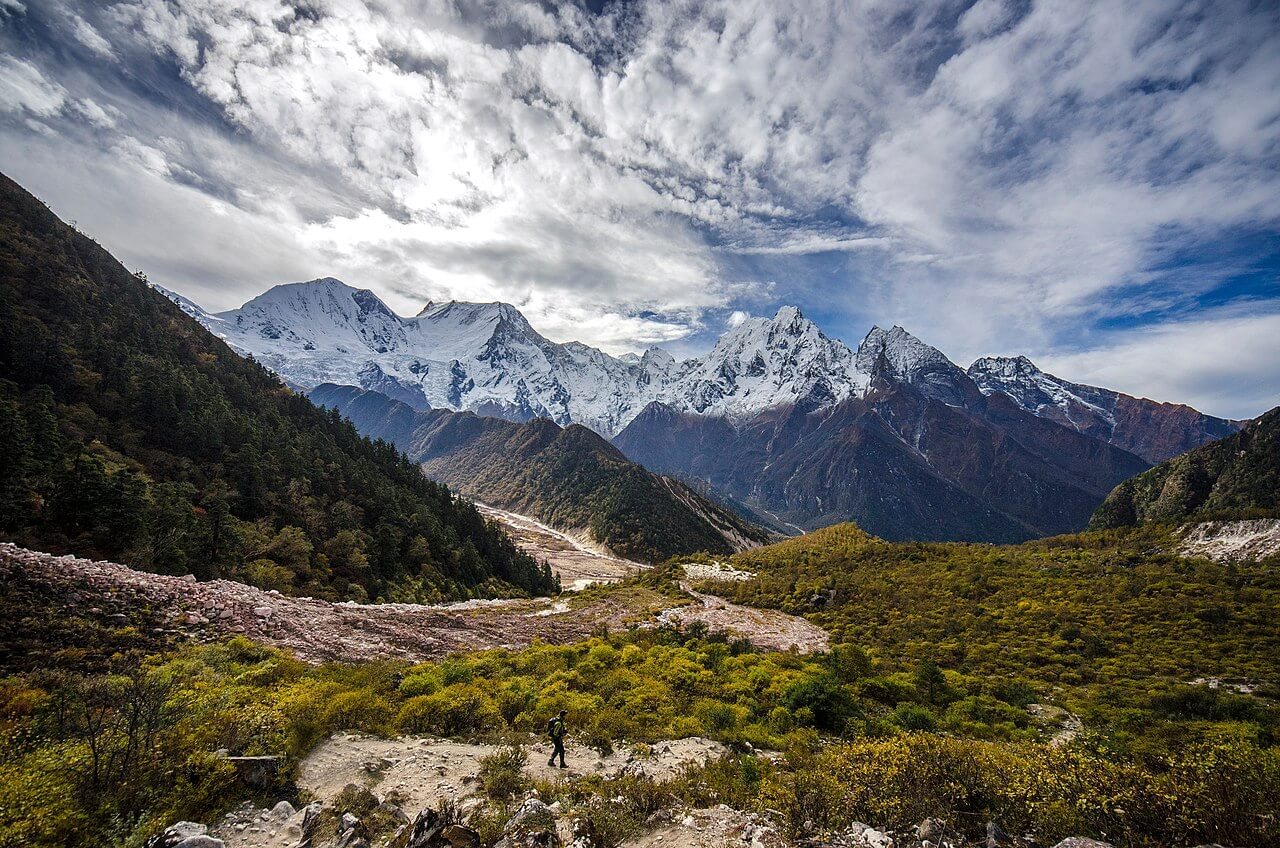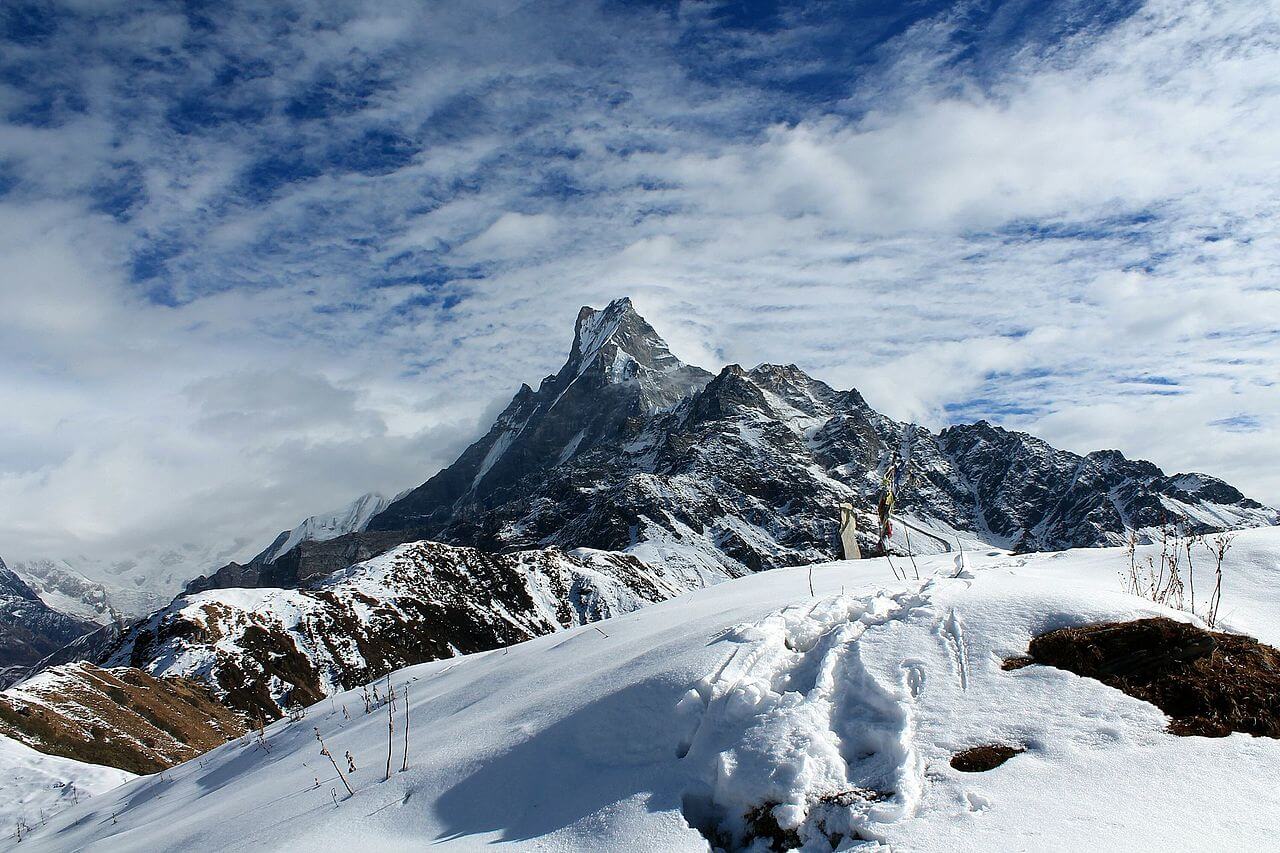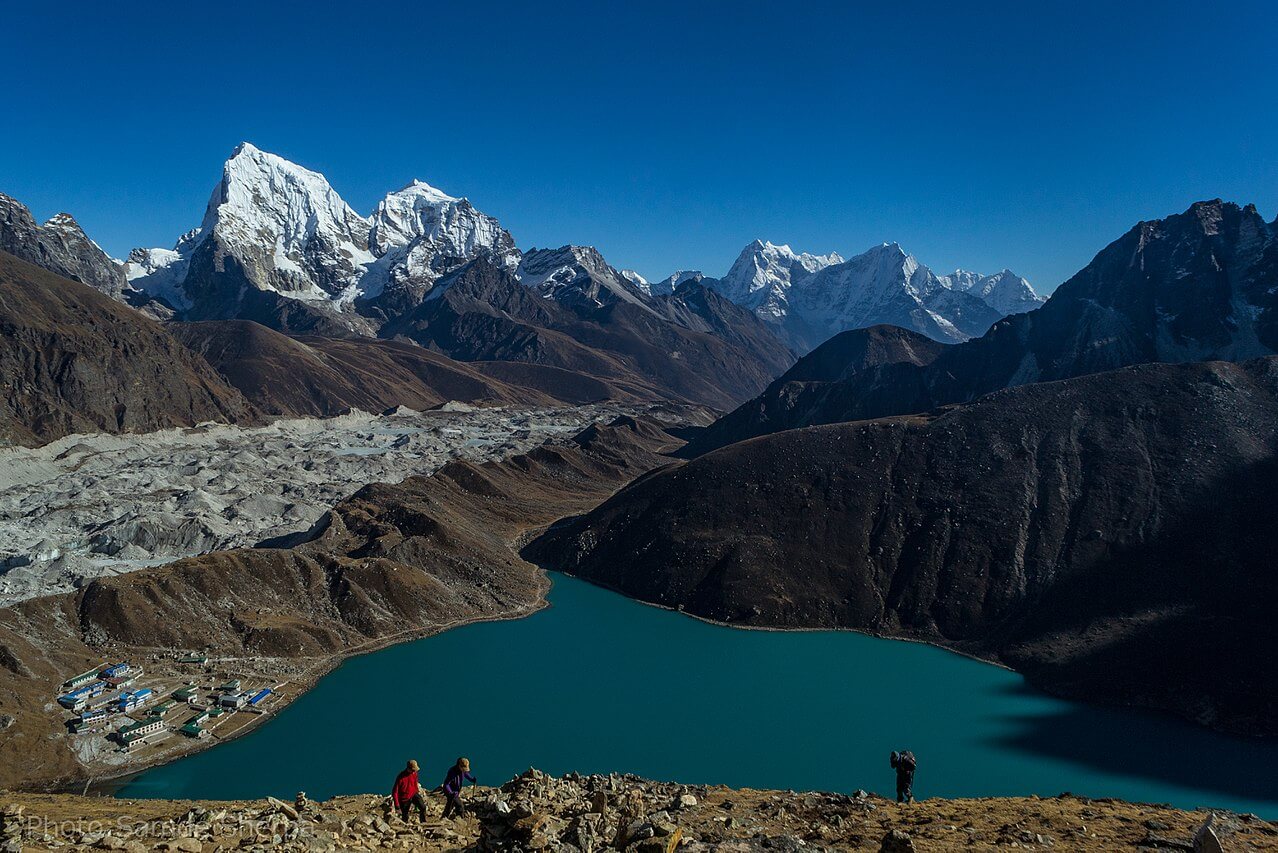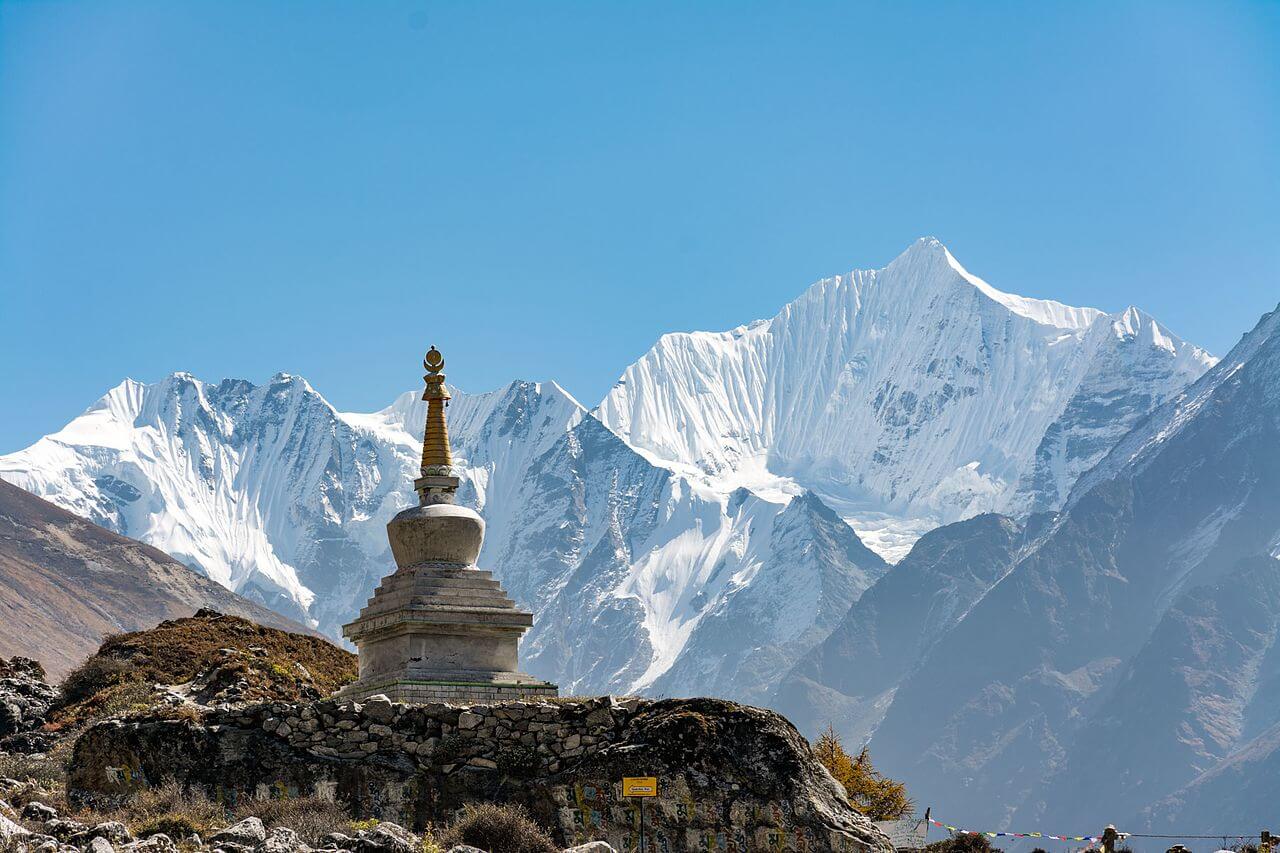Manaslu Circuit Trek
Manaslu Circuit Trek stands less beaten and secluded compared to treks like Everest or Annapurna, but it is equally as impressive as other classic treks.
Manaslu Circuit Trek is the most beautiful as well as demanding treks in Nepal. Trekking in Manaslu is a delightful experience with a blend of adventure, scenery, culture, lifestyle, and wildlife. Located in the western part of Nepal, this trek provides you with an opportunity to encircle around the world’s 8th highest massif, Mt. Manaslu.
Manaslu Circuit Trek rewards you with magnificent spectacles of some of the highest mountains in the world, including Manaslu and Annapurna. With diverse landscapes, unique cultures, rare flora, and fauna, Manaslu is one of the most sought out destinations for avid trekkers. Most of the travelers who choose this trek tend to enjoy less trodden mountain trails rather than the well-known trekking destinations.
Throughout the trail, this trek takes you via the high valleys, isolated villages, ancient monasteries, tranquil lakes, and high Himalayan passes.
Table of Content
Manaslu Circuit Trek Facts
| Trip Duration | 14 Days |
| Maximum Altitude | 5,135m at Larkya La Pass |
| Trip Difficulty | Challenging |
| Accommodation | Teahouse, Hotel |
| Walking Duration | 5-7 hours per day |
| Best Time | Autumn and Spring |
| Group Size | Minimum 2 Persons |
Highlights of Manaslu Circuit Trek
- Comparatively remote and off the beaten trekking destination in the Himalayas of Nepal.
- Diverse landscapes ranging from subtropical forests to the high Himalayan passes.
- Crossing over Larkya La Pass (5,135m), the highest elevation point on the trek.
- Discover the timeless culture and lifestyle of the Manaslu region.
- Enjoy the epic mountain sights as this trek offers glimpses of Mt. Manaslu, Himalchuli, Ngadi Chuli, Ganesh Himal, and Larke Himal.
- Discover rare and abundant wildlife. Manaslu is home to 33 different species of mammals, 110 species of birds, and 211 species of butterflies.
Getting There and Away
Start of the Trek
You’ll start your adventure with a scenic drive from Kathmandu to Soti Khola in Budhi Gandaki Valley. You can drive to Soti Khola (141 km) via 4×4 Jeep (8 hours) or by a local bus (10 hours).
End of the Trek
The endpoint for Manaslu Circuit Trek is Dharapani. You’ll have to take a jeep from Dharapani to Besisahar and switch the vehicle back to Kathmandu.
14 Days Outline Itinerary of Manaslu Trek
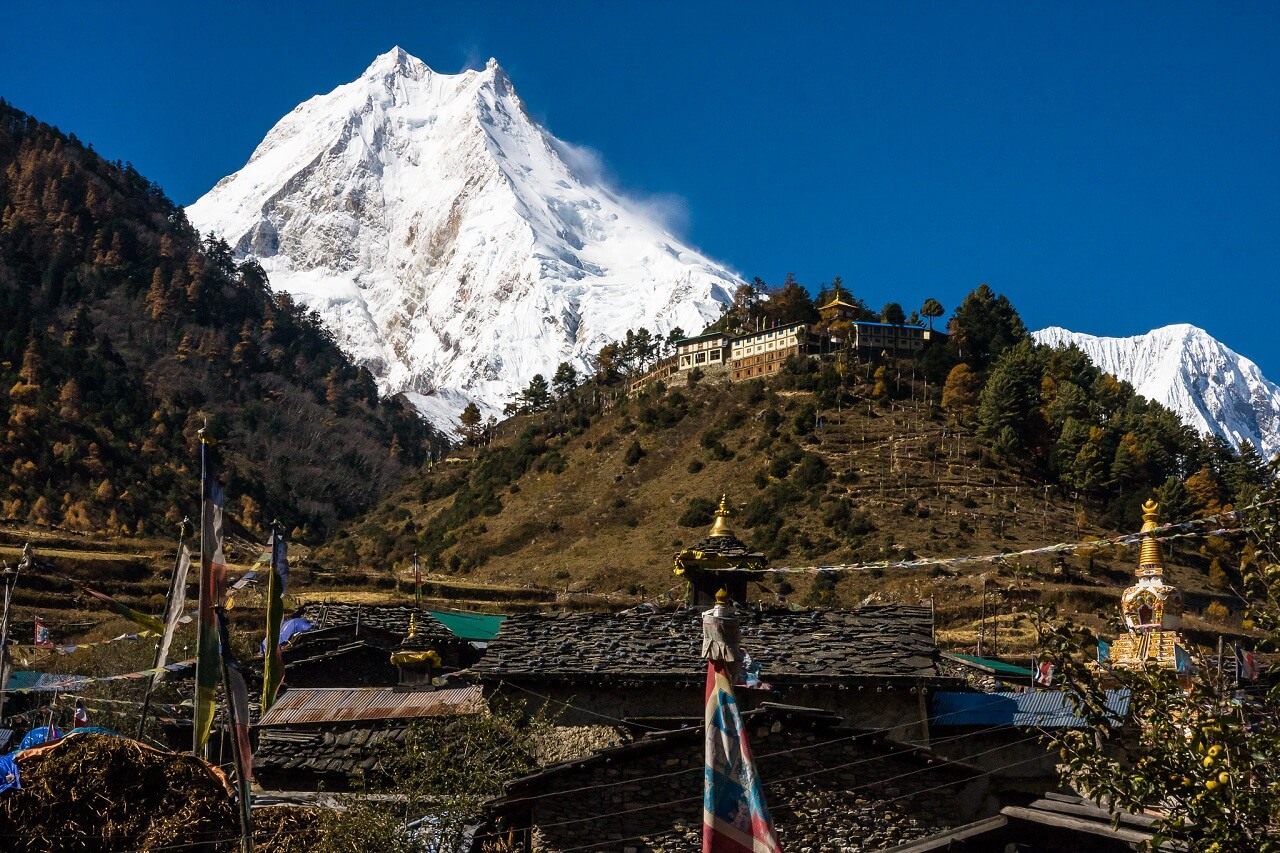
| Day | Itinerary | Overnight | Altitude from (Meter) | Altitude to (Meter) | Trekking Duration |
|---|---|---|---|---|---|
| 1 | Drive from Kathmandu to Soti Khola via Arughat (941m) | Soti Khola | 1,400 | 815 | 8-10 hrs |
| 2 | Trek from Soti Khola to Machha Khola | Maccha Khola | 815 | 900 | 6-7 hrs |
| 3 | Trek from Machha Khola to Jagat | Jagat | 900 | 1,370 | 6-7 hrs |
| 4 | Trek from Jagat to Deng | Deng | 1,370 | 1,865 | 6-7 hrs |
| 5 | Trek from Deng to Namrung | Namrung | 1,865 | 2,630 | 6-7 hrs |
| 6 | Trek from Namrung to Samagaon | Samagaon | 2,630 | 3,525 | 6-7 hrs |
| 7 | Acclimatization Day at Samagaon | Samagaon | 3,525 | 3,525 | - |
| 8 | Trek from Samagaon to Samdo | Samdo | 3,525 | 3,850 | 4 hrs |
| 9 | Acclimatization Day at Samdo | Samdo | 3,850 | 3,850 | - |
| 10 | Trek from Samdo to Dharmasala | Dharmasala | 3,850 | 4,460 | 4-5 hrs |
| 11 | Trek from Dharmasala to Bhimtang via Larkya La Pass (5,135m) | Bhimtang | 4,460 | 3,590 | 8-9 hrs |
| 12 | Trek from Bhimtang to Tilije | Tilije | 3,590 | 2,300 | 5-6 hrs |
| 13 | Trek from Tilije to Dharapani (1,860m) and Drive to Besisahar | Besisahar | 2,300 | 760 | 7-8 hrs |
| 14 | Drive from Besisahar to Kathmandu | Kathmandu | 760 | 1,400 | 5-6 hrs |
Manaslu Circuit Trek 14 Days Detailed Itinerary
Day 1: Drive from Kathmandu (1,400m) to Soti Khola (815m) via Arughat (941m) – 8 to 10 hours
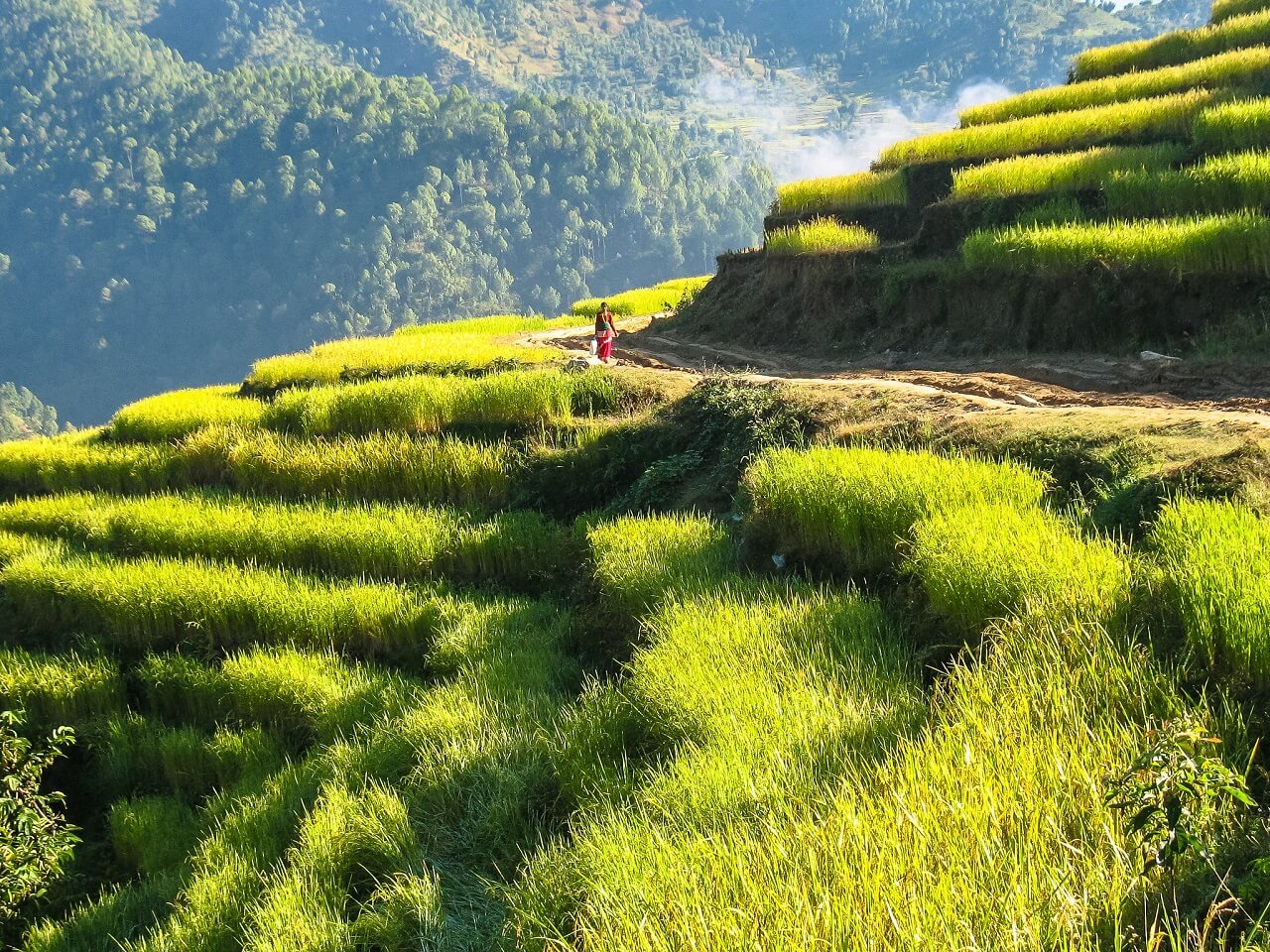
Your adventure to Manaslu Circuit Trek begins with an early morning drive westwards to Soti Khola via the Prithivi Highway. This scenic drive alongside the mighty Trishuli River passes through occasional small towns, breathtaking terrace fields, and lush green hillsides.
Upon reaching the Malekhu Bridge, the vehicle will take a turn towards Dhading Besi, away from the highway. Eventually, you’ll be traveling on a rutted, dirt path towards Arughat as the views of mountains like Annapurna, Manaslu, Ganesh Himal, and Langtang Himal start unfolding in the horizon.
After about 8 to 10 hours of driving, you’ll reach Soti Khola.
Day 2: Trek from Soti Khola (815m) to Machha Khola (900m) – 6 to 7 hours
On this day, your trek starts by crossing the bridge over Soti Khola with a splendid view of the waterfalls. The trail leads to the dense forest before ascending onto the ridge right above the Budhi Gandaki River.
After hiking through the rocky terrain, you’ll arrive at the village of Khursane. Eventually, after descending past the paddy fields, you’ll trek around the Gurung settlement of Lapubesi. Walking along the sandy beds of Budhi Gandaki River, you’ll go down towards the Naulikhola.
Upon crossing the suspension bridge over the river, you’ll arrive at the tiny settlement of Machha Khola.
Day 3: Trek from Machha Khola (900m) to Jagat (1,370m) – 6 to 7 hours
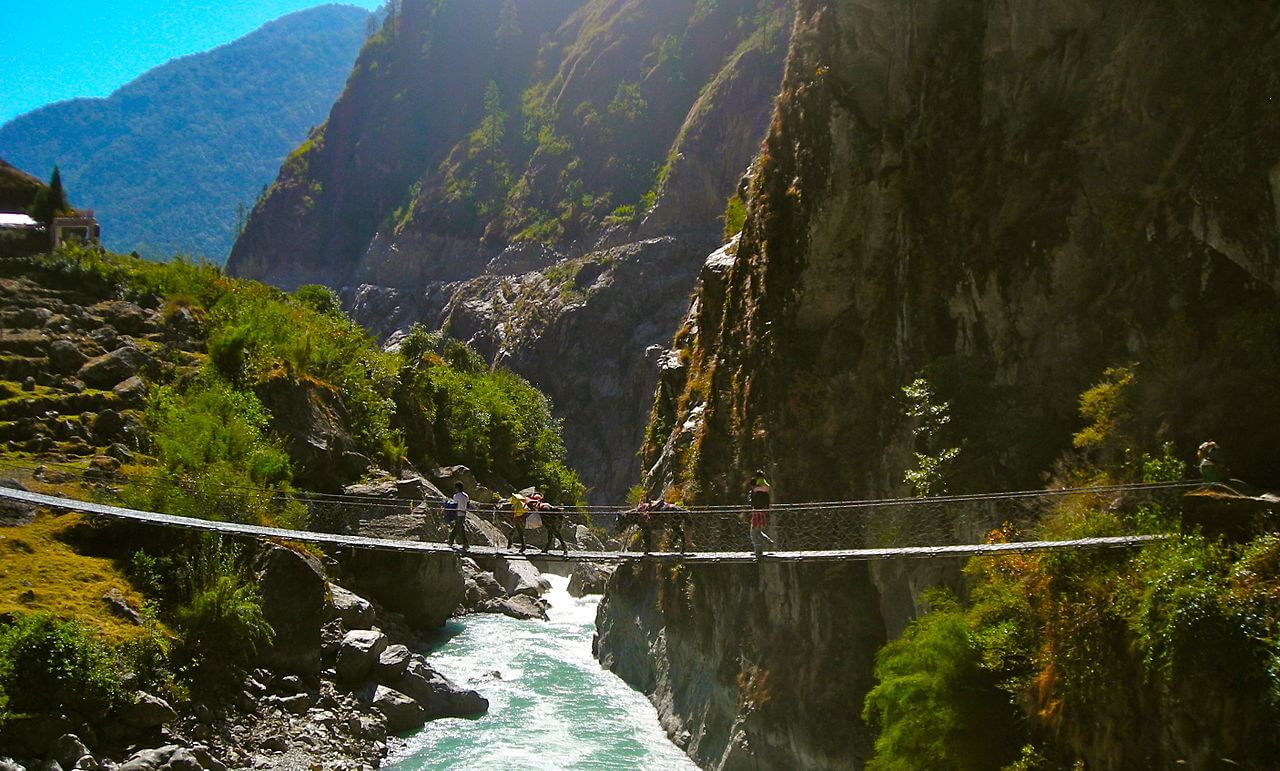
Today, the day may get slightly strenuous as the trail to Maccha Khola leads to several uphills and downhills. Your day begins following the narrow paths along the gorge with a gentle uphill and downhill. After a while, you will cross Tharo Khola to reach another Gurung village at Khorla Besi.
As the trail ascends and descends, you will arrive at a natural hot spring in Tatopani. After arriving at Tatopani, you’ll climb a steep ridge then cross the Budhi Gandaki River via a suspension bridge. The trail then heads over the hill towards Doban after climbing up the stone steps.
After crossing the suspension bridge over Yarkhu Khola, the trail leads to another steep section of the stone staircase. The trail then navigates towards the river before ascending through some more stone steps towards Thado Bharyang.
Heading across the west bank of Budhi Gandaki River, you’ll climb over the ridge and walk alongside the river towards Jagat. The village of Jagat is the entry point of the Manaslu Conservation Area (MCA).
Day 4: Trek from Jagat (1,370m) to Deng (1,865m) – 6 to 7 hours
You begin the day with a steep ascent over the rocky ridge to Salleri, then make a gentle descend towards Sirdibas. Then, continue trekking towards Ghatta Khola and cross a long suspension bridge to arrive at Philim, a large Gurung village.
The trail now heads northward across the millet fields to Ekle Bhatti. You navigate through the sloppy grasslands then cross the Budhi Gandaki river. After you walk along the riverbank, the narrow trail opens up through the valley. You’ll then walk in the shades of bamboo forests towards the Deng Khola. Upon crossing the river, you’ll reach your destination, Deng.
Day 5: Trek from Deng (1,865m) to Namrung (2,630m) – 6 to 7 hours
After leaving Deng behind, you commence the day by crossing the Budhi Gandaki river. From the bridge, make a gentle ascend to reach the trail from Bhi. Now, head westwards up the Budhi Gandaki Valley and walk past the lush green jungles and traditional villages of Manaslu.
Although there are a few alternative options, this itinerary takes the route that passes through the village of Prok. The viewpoint of the settlement offers a magnificent view of the Siringi Himal. You cross the Budhi Gandaki river time and again today and walk past the ancient monasteries en route to Namrung.
The trail navigates along the river upstream under the shade of the dense bamboo forest until you reach Namrung.
Day 6: Trek from Namrung (2,630m) to Samagaon (3,525m) – 6 to 7 hours
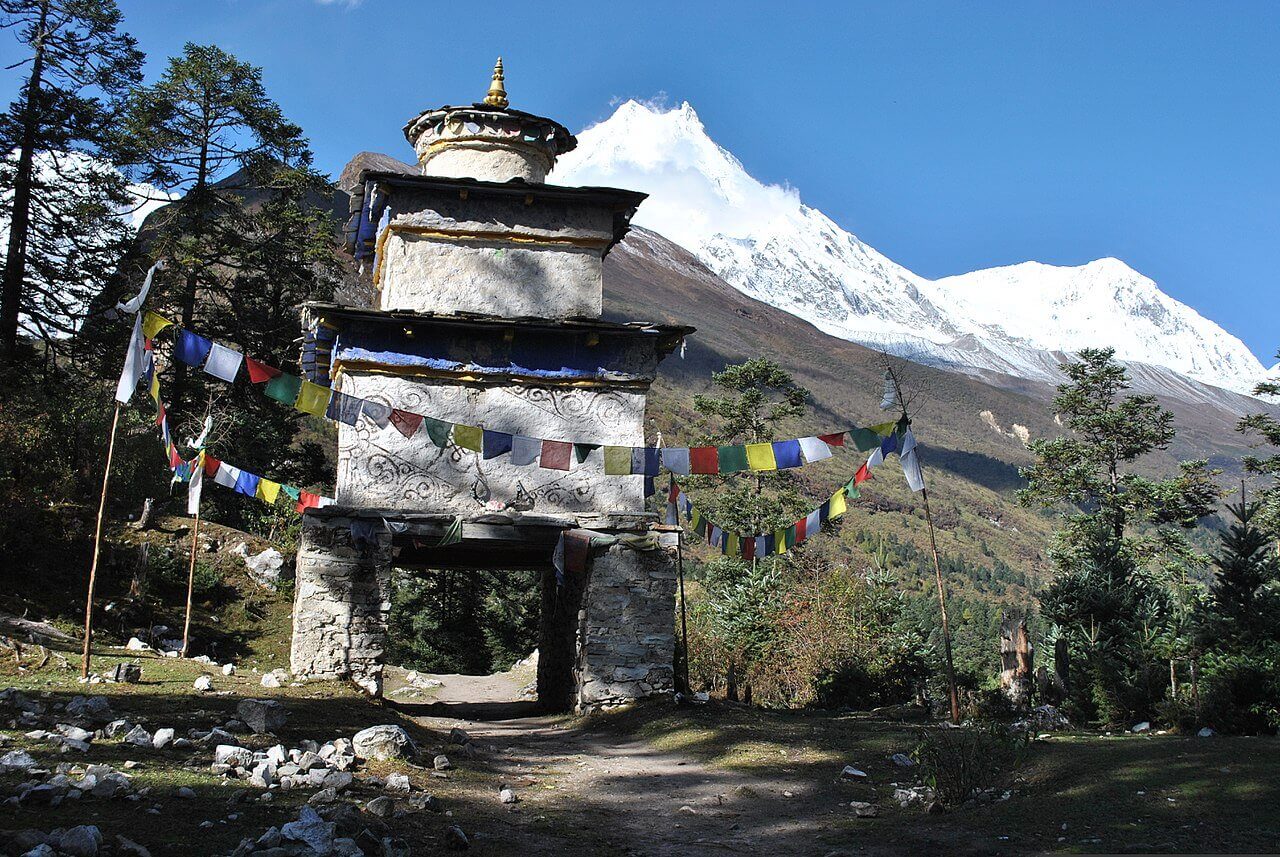
Namrung village offers a magnificent sight of Siring Himal, Ganesh Himal, and Mt. Himal Chuli. After enjoying the morning spectacles of the Himalayas, the trail leads uphill through the lush green forest to reach Lihi village.
Furthermore, you walk past several remote villages like Sho, Lho, and Shyala before arriving at Samagaon. Upon reaching Lho, you will enjoy the extraordinary view of the world’s 8th highest mountain, Mt. Manaslu. Snow-capped mountains surround Shyala village from all directions — Himal Chuli and Peak 29 (Ngadi Chuli) on the left, Mt. Manaslu and its glacier up ahead, and Ganesh Himal on the far right.
Your adventure for the day ends as you reach Samagaon.
Day 7: Acclimatization Day at Samagaon (3,525m)
A much-required rest day at Samagaon to acclimatize with the higher altitudes. On this day, you can choose to take a rest in the teahouse or hike around the nearby destination to keep your feet stretched.
For those who want to explore around instead, you can take a short hike up to an old monastery, Pungyen Gompa. This ancient monastery offers an excellent view of the glacier.
Day 8: Trek from Samagaon (3,525m) to Samdo (3,850m) – 4 hours
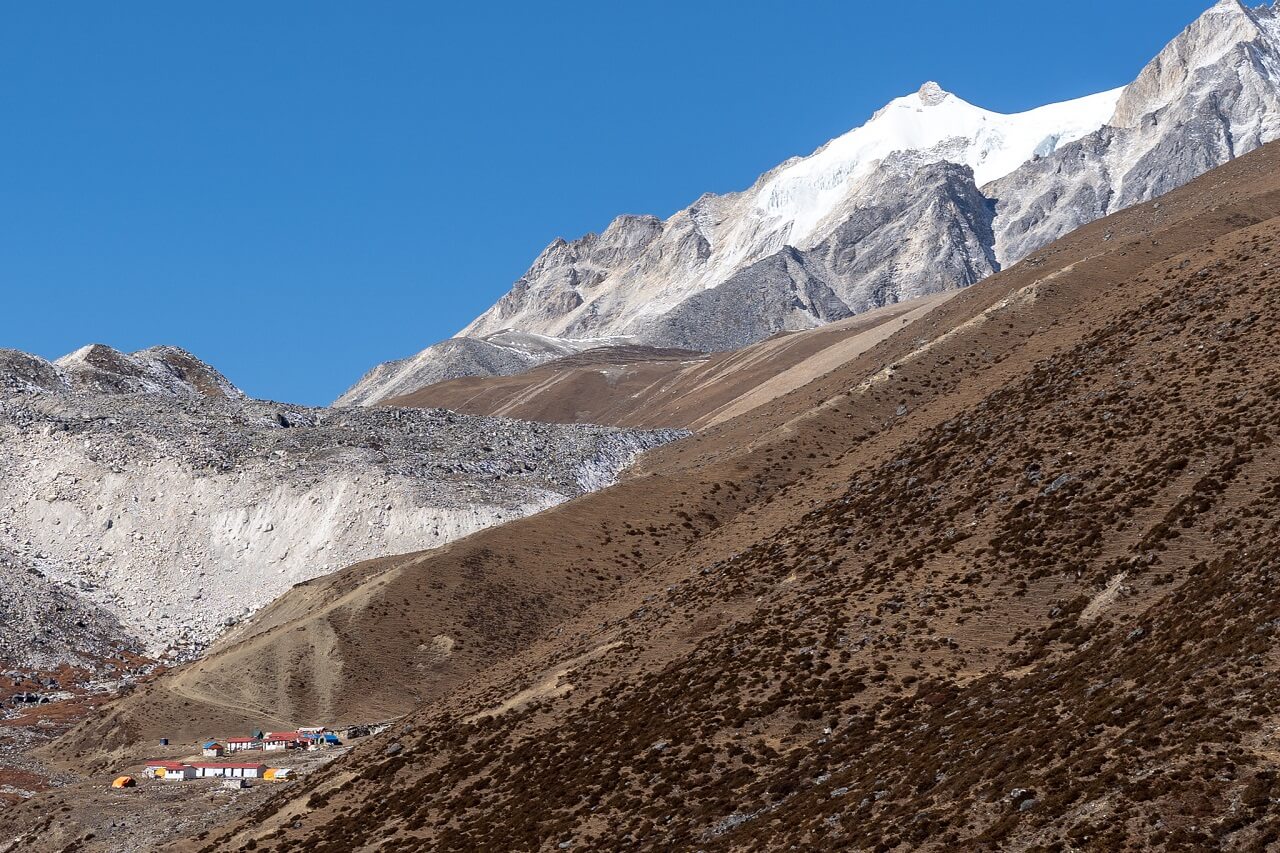
Begin your day with a slight descend to Budhi Gandaki River then head towards the bridge over a side stream. The valley begins to open spread out as you walk across several Mani walls. Enjoy the magnificent views of the mountains along the trail as you edge closer to the Tibetan border.
Then, the trail leads to an accessible route right above the river under the shades of birch and juniper forests. Samdo offers an excellent view of the mountains, especially Mt. Manaslu. Since Samdo is a village of Tibetan refugees, Tibetan Buddhism widely dominates the area.
Day 9: Acclimatization Day at Samdo (3,850m)
Another acclimatization day at Samdo begins before heading to the challenging sections of the trek. There are a couple of alternatives for day hikes in Samdo.
The first option is an easy walk to the valley directly behind the Samdo village. The trail offers magnificent mountain views including Mt. Manaslu, Hiunchuli, Simrang, Ngadi, and Larke Peak.
Another option is to hike towards Gya La, a long pass north of the village. Excursion to Gya La is slightly longer and more strenuous than the first one.
Day 10: Trek from Samdo (3,850m) to Dharmasala (4,460m) – 4 to 5 hours
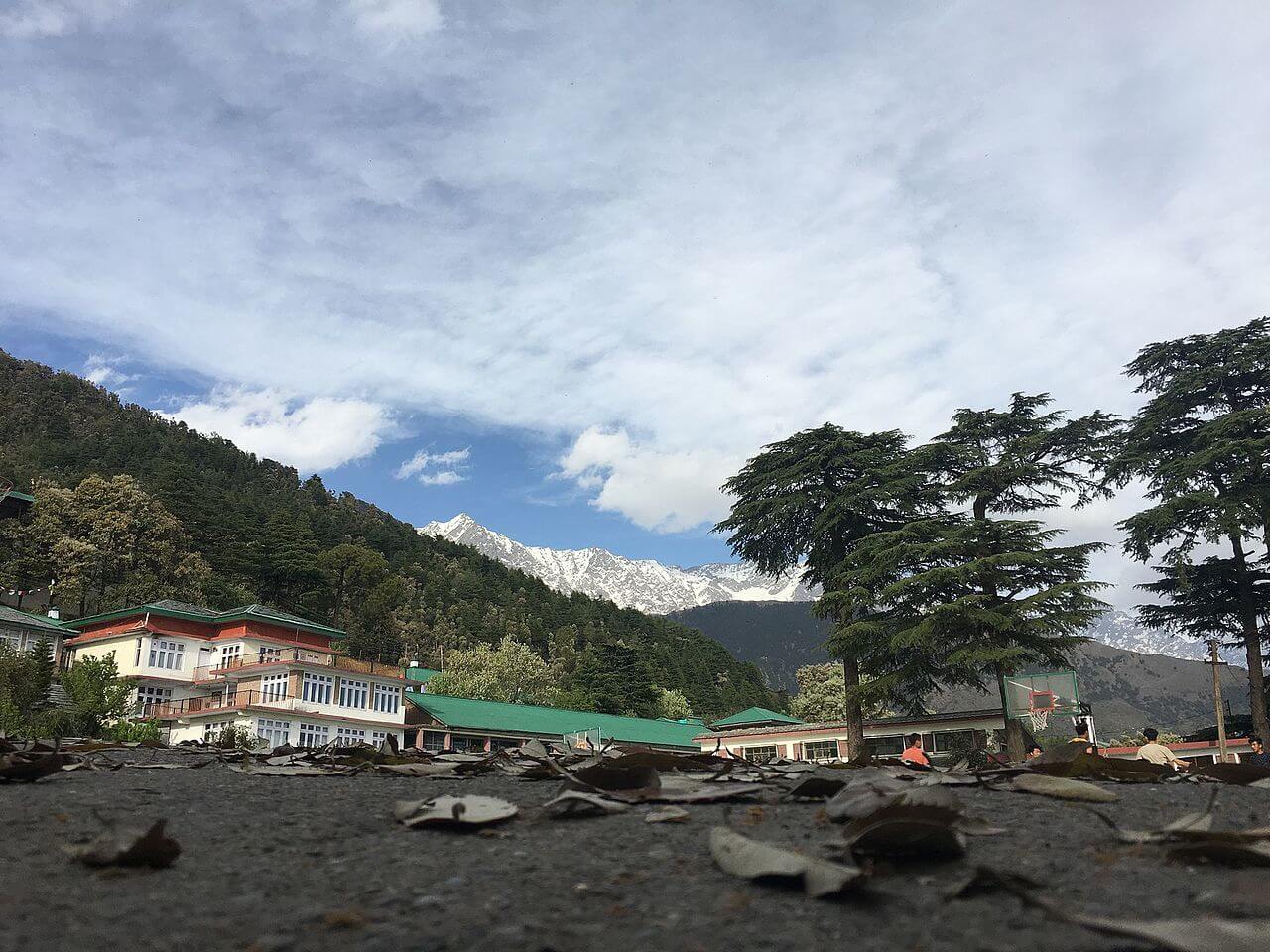
Upon leaving Samdo, you’ll walk past Larke Bazar, a seasonal Tibetan market, then descend towards the Budhi Gandaki river and cross the small wooden bridge. You’ll pass a couple of streams while relishing the Larkya Glacier.
After trekking around the valley of Salka Khola, you’ll climb steep uphill towards Dharmasala.
Day 11: Trek from Dharmasala (4,460m) to Bhimtang (3,590m) via Larkya La Pass (5,135m) – 8 to 9 hours
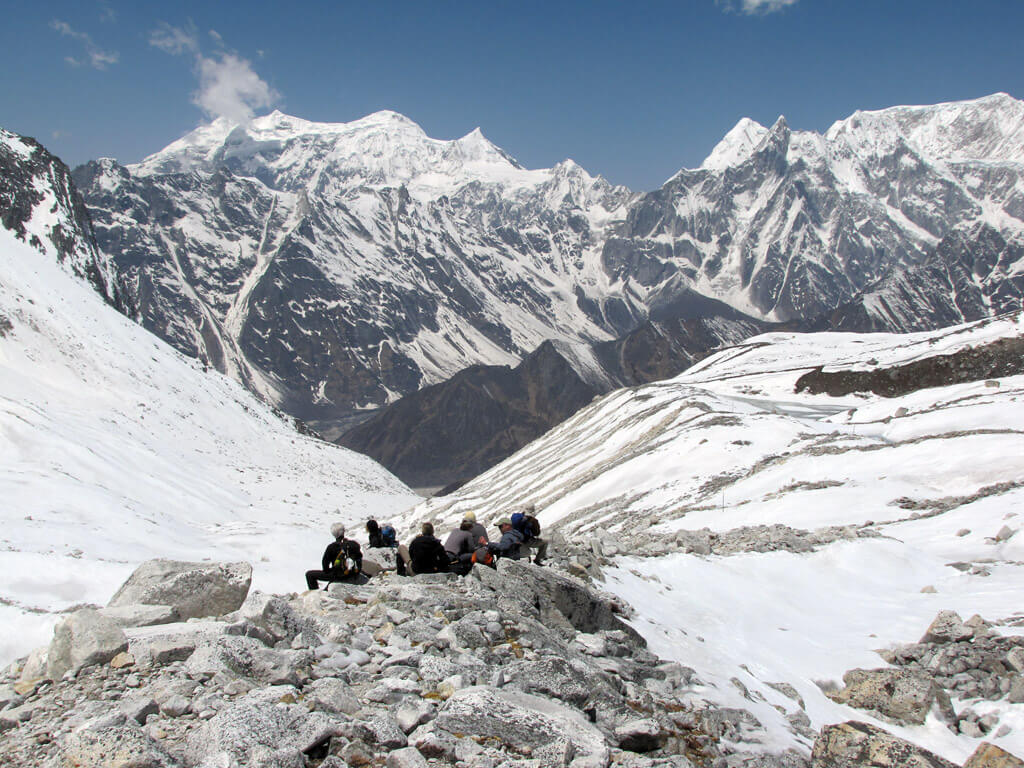
Today marks as the most prolonged and most strenuous day of the entire Manaslu Circuit. Therefore, make sure to begin your adventure early in the morning. Your journey starts with a gentle uphill to a small valley north of Larkya Glacier. The valley provides breathtaking views of Larkya Peak and Cho Danda.
Furthermore, make a gradual ascent across the moraine of the glacier until you reach the upper section of the pass. In the upper reaches of Larkya La Pass, the climb becomes steeper. However, the pass is rewarding with beautiful spectacles of the mountains, including Annapurna II, Himlung Himal, and Cheo Himal.
The trail then descends to the low pastures until you arrive at Bhimtang.
Day 12: Trek from Bhimtang (3,590m) to Tilije (2,300m) – 5 to 6 hours
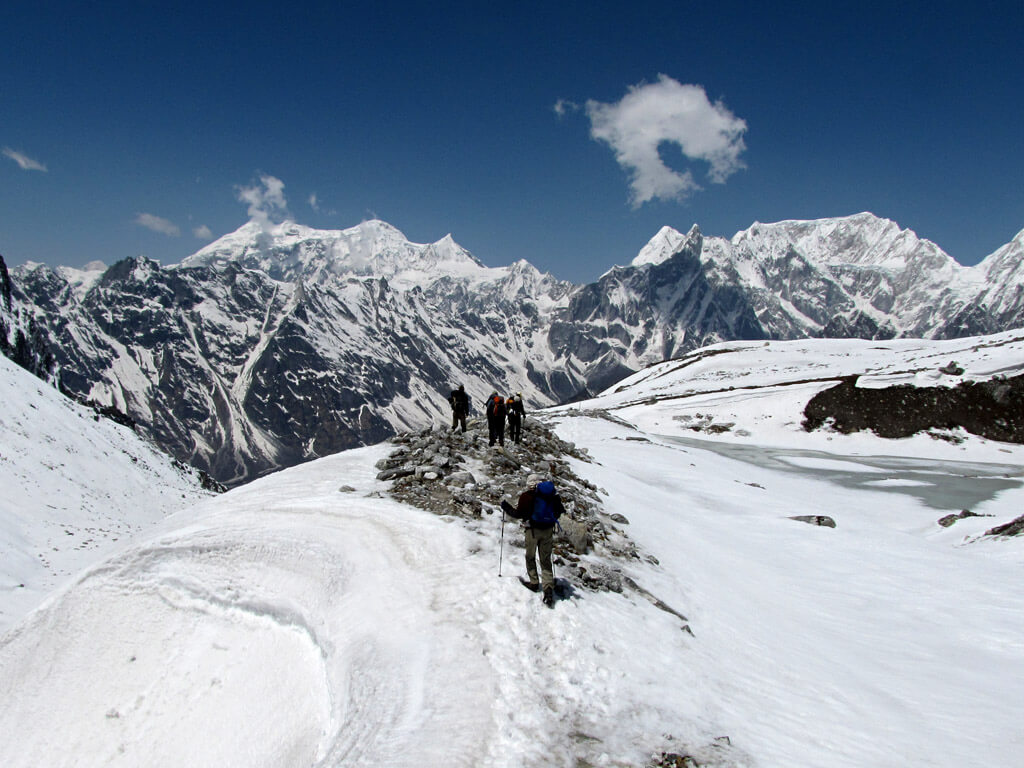
After a long day at Larkya La Pass, you commence the day by descending the Budhi Gandaki river. After crossing the wooden bridge over the river, you’ll walk along the dense rhododendron forest and head toward the narrow valley towards Karche, the highest cultivated land of Budhi Gandaki Valley.
Following a few hours of walking on the river banks, you’ll arrive at the village of Gho. Then, continue walking until you reach your destination, Tilije.
Day 13: Trek from Tilije (2,300m) to Dharapani (1,860m) and Drive to Besisahar (760m) – 7 to 8 hours
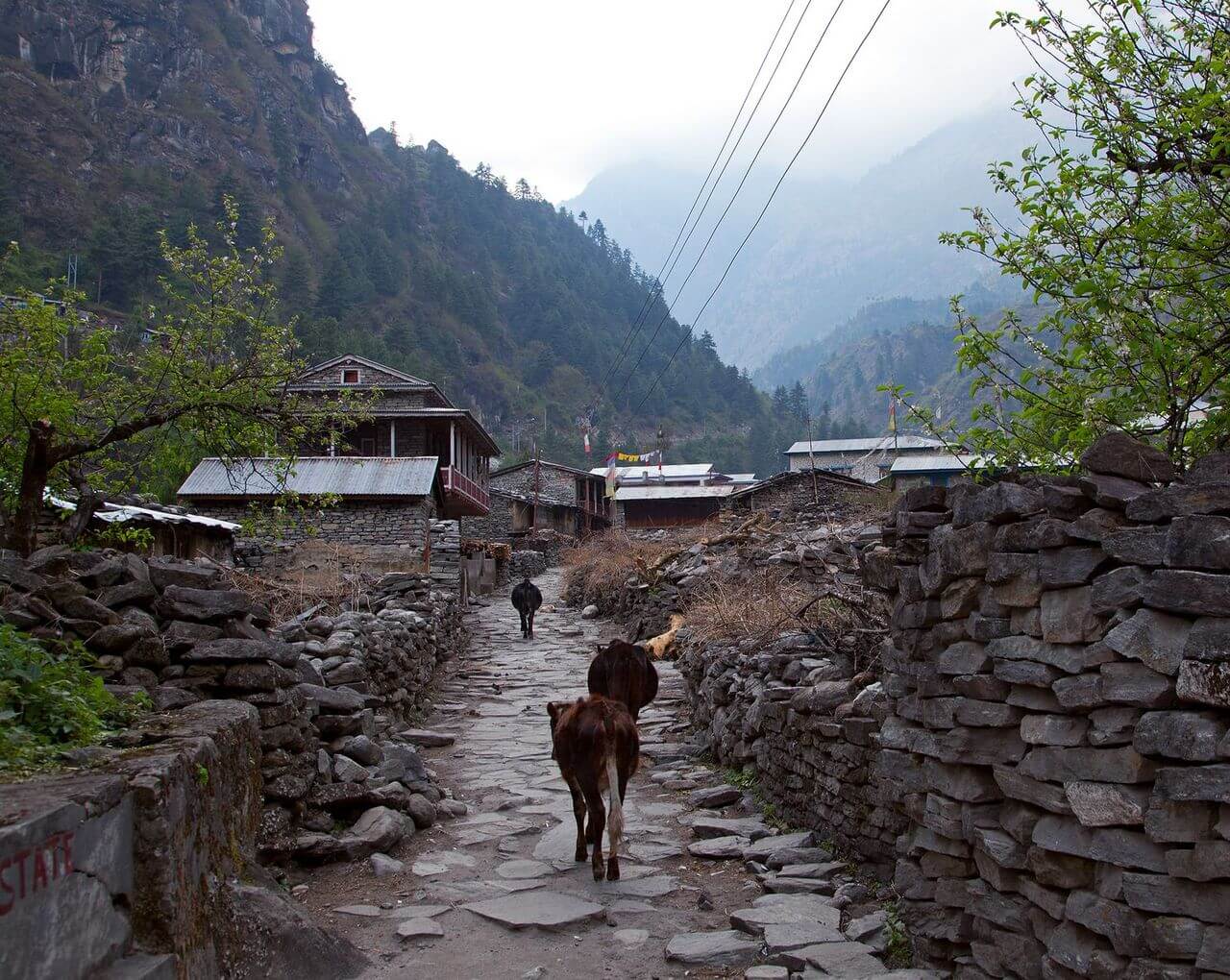
Walking through the beautiful villages, you cross the bridge over the Dudh Koshi river and head past several Mani walls and an arch to arrive at Thonje village. The trail further leads to the occasional police check-posts before entering the route to Annapurna Circuit at Dharapani.
From here, you can hire a jeep or even take a local bus to Besisahar from Dharapani. It makes you about 4-5 hours to reach Besisahar from Dharapani.
Day 14: Drive from Besisahar (760m) to Kathmandu (1,400m) – 5 to 6 hours
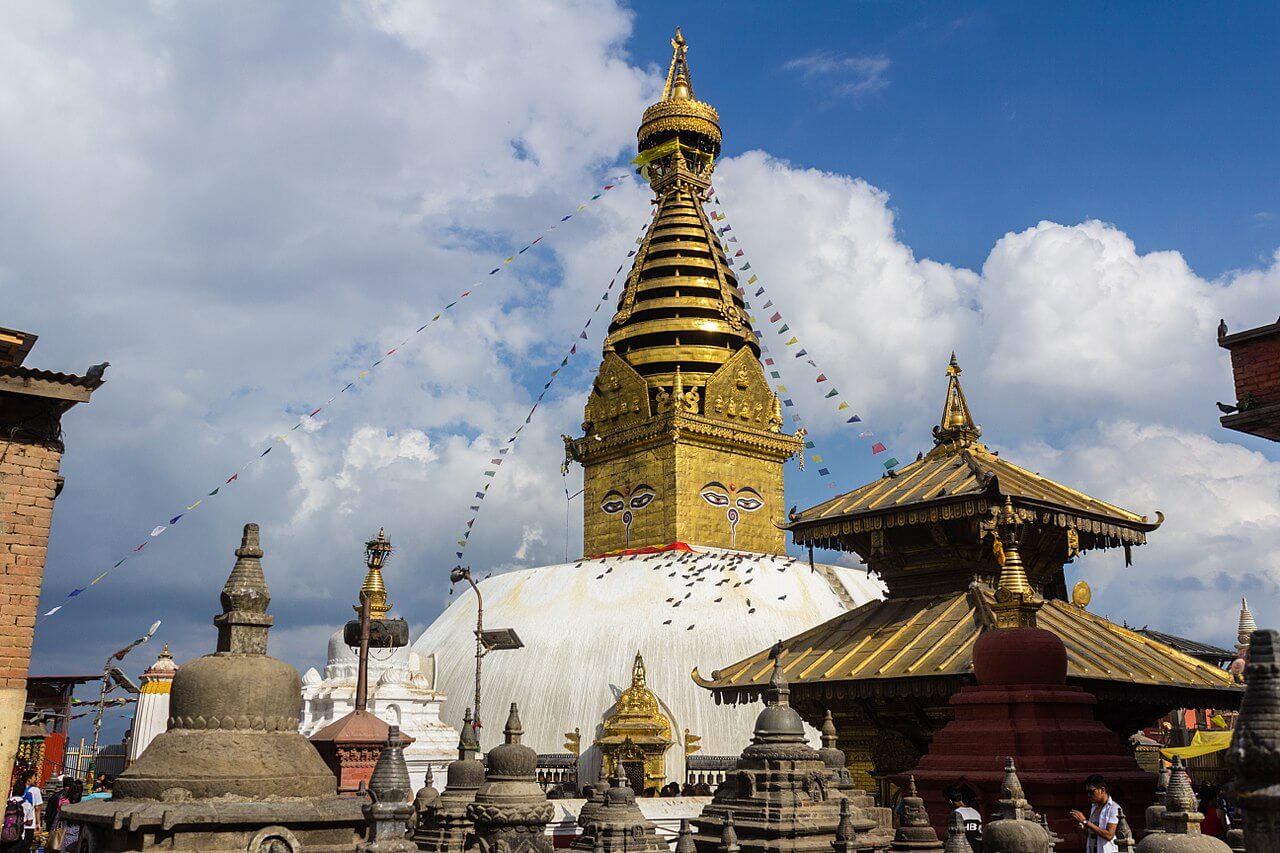
Begin in the morning with a scenic drive across several small villages. You drive along the Prithivi Highway, enjoying the beautiful scenery of hills, flowing rivers, terrace fields, small towns, and occasional mountains.
After driving for about 5-6 hours, you’ll reach Kathmandu.
Tsum Valley Extension
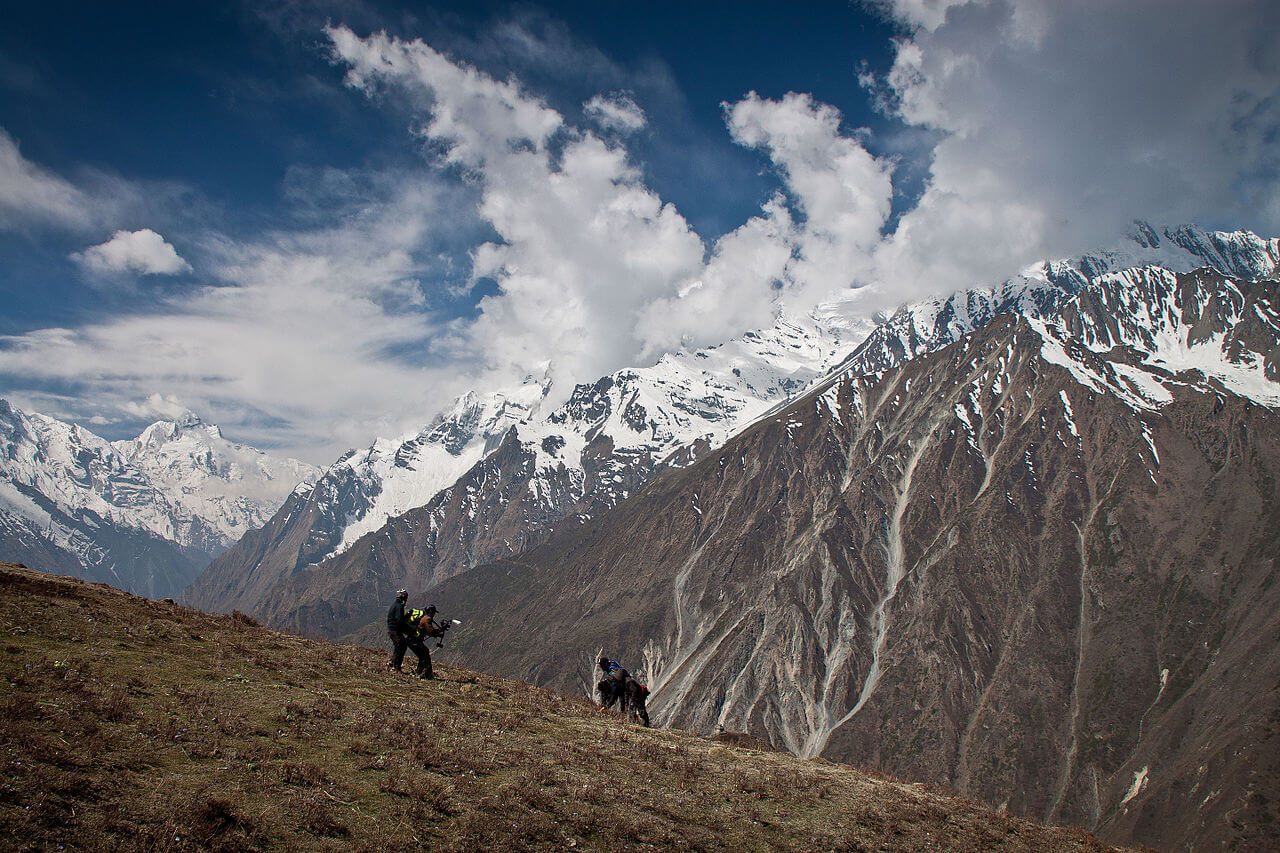
If you have a few extra days, you can extend your Manaslu trek for another week by adding Tsum Valley Trek to your itinerary. The trail to Tsum Valley is even more isolated and remote compared to that of Manaslu Circuit.
Tsum Valley Trek offers an authentic experience with ancient art culture, Himalayan valleys, and spectacular mountain scenery. This trek rewards the incredible mountain spectacles with Ganesh Himal, Shringi Himal, and Boudha Himal surrounding the trail.
Tsum Valley Trek is an opportunity for local experiences as the trek is well-known for its warm hospitality and traditional homestays. You’ll also get an insight into Tibetan Buddhism as you will be exploring the ancient Buddhist monasteries, including Milarepa’s Cave, Mu Gompa, and Rachen Gompa.
| Day | Itinerary | Overnight | Altitude from (Meter) | Altitude to (Meter) | Trek Duration |
|---|---|---|---|---|---|
| 1 | Drive from Kathmandu to Soti Khola | Soti Khola | 1,400 | 815 | 8-10 hrs |
| 2 | Trek from Soti Khola to Machha Khola | Maccha Khola | 815 | 900 | 6-7 hrs |
| 3 | Trek from Machha Khola to Jagat | Jagat | 900 | 1,370 | 6-7 hrs |
| 4 | Trek from Jagat to Philim | Philim | 1,370 | 1,590 | 3 hrs |
| 5 | Trek from Philim to Chumling | Chumling | 1,590 | 2,360 | 6-7 hrs |
| 6 | Trek from Chumling to Chhokangparo | Chhokangparo | 2,630 | 3,010 | 5-6 hrs |
| 7 | Trek from Chhokangparo to Nile via Milarepa Cave | Nile | 3,010 | 3,361 | 6-7 hrs |
| 8 | Trek from Nile to Mu Gompa | Mu Gompa | 3,361 | 3,700 | 1-2 hrs |
| 9 | Trek from Mu Gompa to Rachen Gompa | Rachen Gompa | 3,700 | 3,300 | 3-4 hrs |
| 10 | Trek from Rachen Gompa to Gumba Lungdang | Gumba Lungdang | 3,300 | 3,200 | 5-6 hrs |
| 11 | Trek from Gumba Lungdang to Lokpa | Lokpa | 3,200 | 2,240 | 7-8 hrs |
| 12 | Trek from Lokpa to Ghap | Ghap | 2,240 | 2,160 | 4-5 hrs |
| 13 | Trek from Ghap to Lho | Lho | 2,160 | 3,180 | 5-6 hrs |
| 14 | Trek from Lho to Samagaon | Samagaon | 3,180 | 3,580 | 2-3 hrs |
| 15 | Excursion to Manaslu Base Camp (4,400m) | Samagaon | 3,580 | 3,580 | 3-4 hrs |
| 16 | Trek from Samagaon to Samdo | Samdo | 3,580 | 3,875 | 2-3 hrs |
| 17 | Excursion to Samdo Ri | Samdo | 3,875 | 3,875 | 3-4 hrs |
| 18 | Trek from Samdo to Dharamsala | Dharamsala | 3,875 | 4,460 | 2-3 hrs |
| 19 | Trek from Dharamsala to Bimtang via Larke Pass (5,160m) | Bimtang | 4,460 | 3,590 | 7-9 hrs |
| 20 | Trek from Bimtang to Dharapani | Dharapani | 3,590 | 1,963 | 7-9 hrs |
| 21 | Drive from Dharapani to Kathmandu via Jeep | Kathmandu | 1,963 | 1,400 | 9-10 hrs |
Side Trips of Manaslu Trek
If you have a day or two, Manaslu Trek offers plenty of marvelous side trips you can take along with the standard route. Manaslu Circuit has a few more remote and off-the-beaten destinations where only a few dedicated travelers make their ways. Therefore, if there is enough time, we highly recommend you consider some of these options along the trail.
1. Manaslu Base Camp (4,848m)
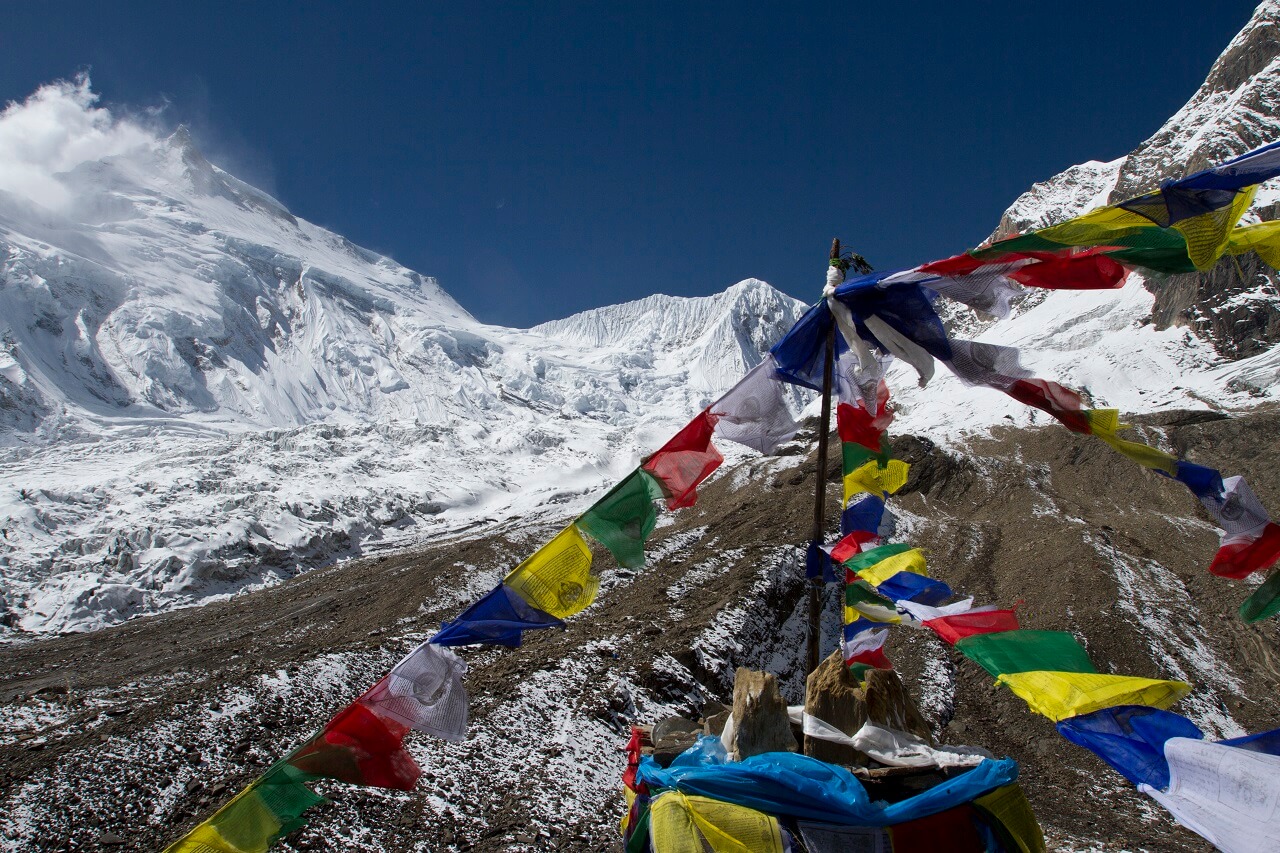
Manaslu Base Camp is an excellent side trip of Manaslu Circuit Trek. The entire trip to the base camp of the world’s 8th highest mountain takes about 6 hours for average trekkers.
The trail to the Manaslu Base Camp diverts from the Manaslu Circuit route in Samagaon. There are two different alternatives to go to the base camp. The first one is to take the course to Birendra Lake, then head to the base camp. Another one is to walk out of Samagaon, take the left lane, and head directly to the base camp. A small Chorten surrounded with colorful prayer flags marks the Manaslu Base Camp.
2. Birendra Lake (3,620m)
Birendra Lake is by far the most popular side trip in Manaslu Circuit Trek. Formed from the melting ice of Manaslu, you can reach this glacial lake in about half an hour from Samagaon.
Most of the trekkers visit this pristine lake on the acclimatization day in Samagaon. To visit this lake, you’ll have to follow the trail opposite to Mount Manaslu Hotel. The roads to the lake can be slightly tricky, so keep your eyes on the path.
3. Kalmachum Lake (3,800m)
Kalmachum Lake, also known as Kal Tal, is a high altitude lake situated at an elevation of 3,800m. You’ll have to hike for an entire day from the village of Prok to reach this lake.
Dense forests with Langurs, fir, and pine surround the trail to Kalmachum Lake. The first few hours of the hike is steep uphill, which later turns to a gradual walk until you arrive at the lake. You can see the splendid view of Prok and Kok village from the top.
4. Hinang Gompa (3,100m)
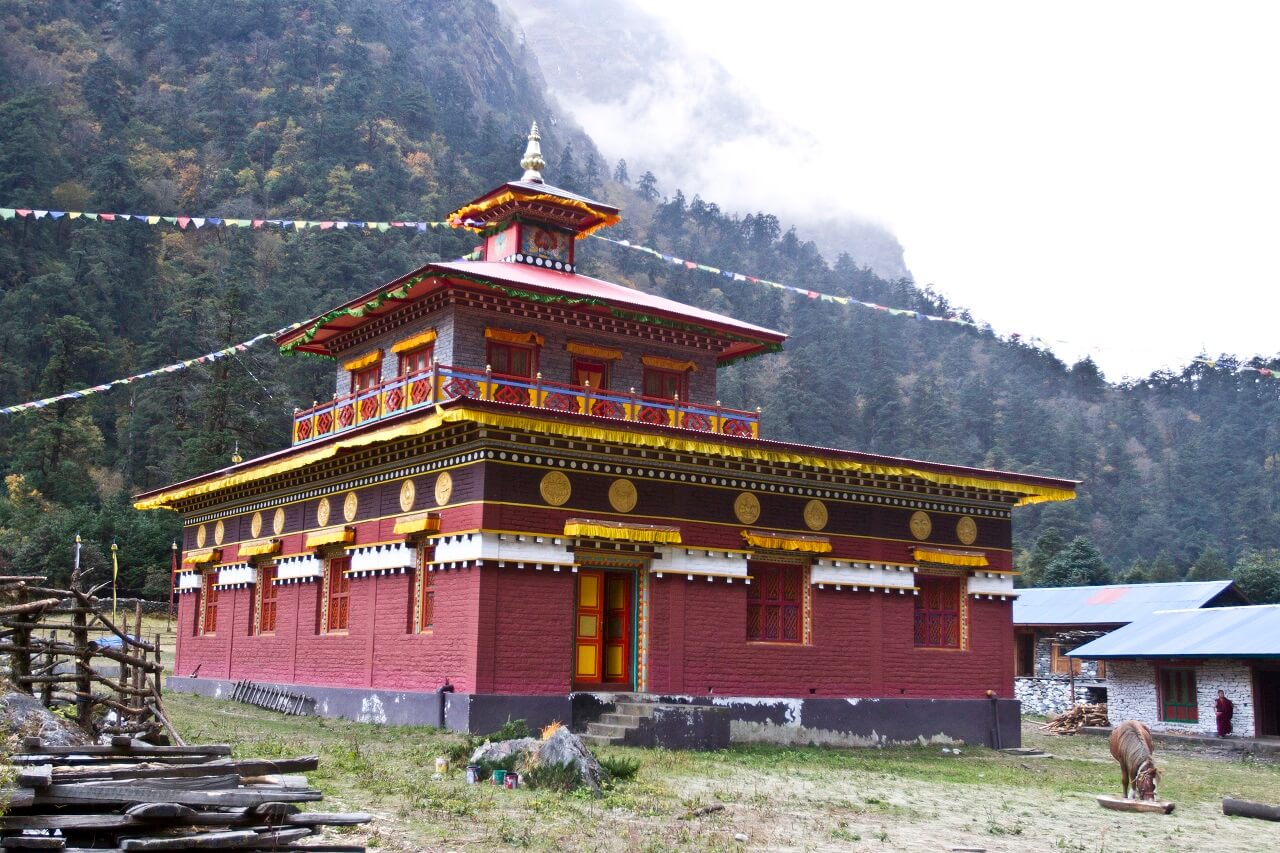
Hinang Gompa is a beautiful monastery that sits on the top of a hill decorated with Mt. Himalchuli in the backdrop. The road to this monastery diverts from 20 minutes away from Lihi village.
This monastery is a decade old and currently also serves as a Lama school. If you hike further up from the monastery, you’ll also get to visit Hinang glacier.
5. Serang Gompa (3,100m)
Located in the foothills of Shringi Himal, Serang Gompa is one of the most secluded and spiritual monasteries in Manaslu Circuit. Since the valley surrounding gompa is said to be the place where Guru Padmasambhava once meditated, it is one of the must-visit side trips in the trek.
Shringi Himal on the backdrop also carries a religious significance. Dense woodland, beautiful Chorten, Mani walls, and suspension bridge encompass the route to the monastery.
Best Time to Trek Manaslu Circuit
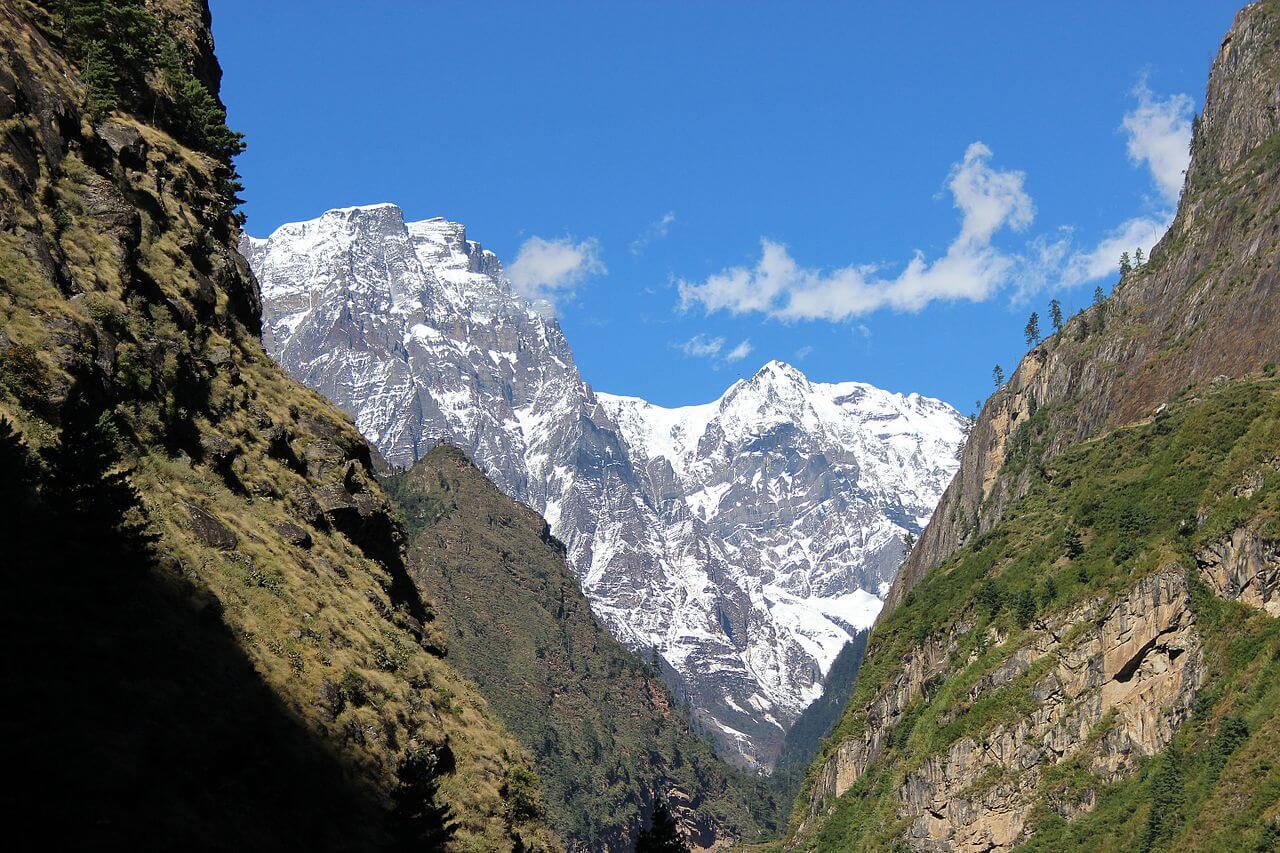
The best time to trek in Manaslu Circuit is during Spring (March to May) and Autumn (September to November). Since the weather conditions during these seasons tend to be moderate, and the skies are usually clear, people consider it to be the most favorable time to go trekking in Nepal.
Traveling during Spring and Autumn means the temperature is relatively moderate for walking and tends to remain more stable. You also enjoy the marvelous views of the mountains and landscapes as the skies remain clear even during the days.
Unlike most of the treks in Nepal, Manaslu is not a year-long trekking destination. Since you’ll be walking through the landslide-prone areas, it is not advisable to trek to Manaslu during the Monsoon (June to August).
Winter (December to February) are usually cold and snowy. You’ll have to walk through the moraines of the glaciers and cross over Larkya La Pass on this trek. Therefore, trekking in winter will be quite tricky. So, it is not advisable to trek to Manaslu during this time of the year.
Here’s a table with average temperature and rainfall details throughout the year for locations en-route to Manaslu Circuit:
| Location | Elevation (meters) | Average Minimum Temperature (°C) | Average Maximum Temperature (°C) | Annual Rainfall (mm) |
|---|---|---|---|---|
| Kathmandu | 1,400 | 10.1 | 23.6 | 1505 |
| Jagat | 1,370 | 11.4 | 23.4 | 2056 |
| Samagaon | 3,525 | -0.8 | 12 | 386 |
| Besisahar | 760 | 13.6 | 25.3 | 3041 |
Manaslu Circuit Trek Difficulty
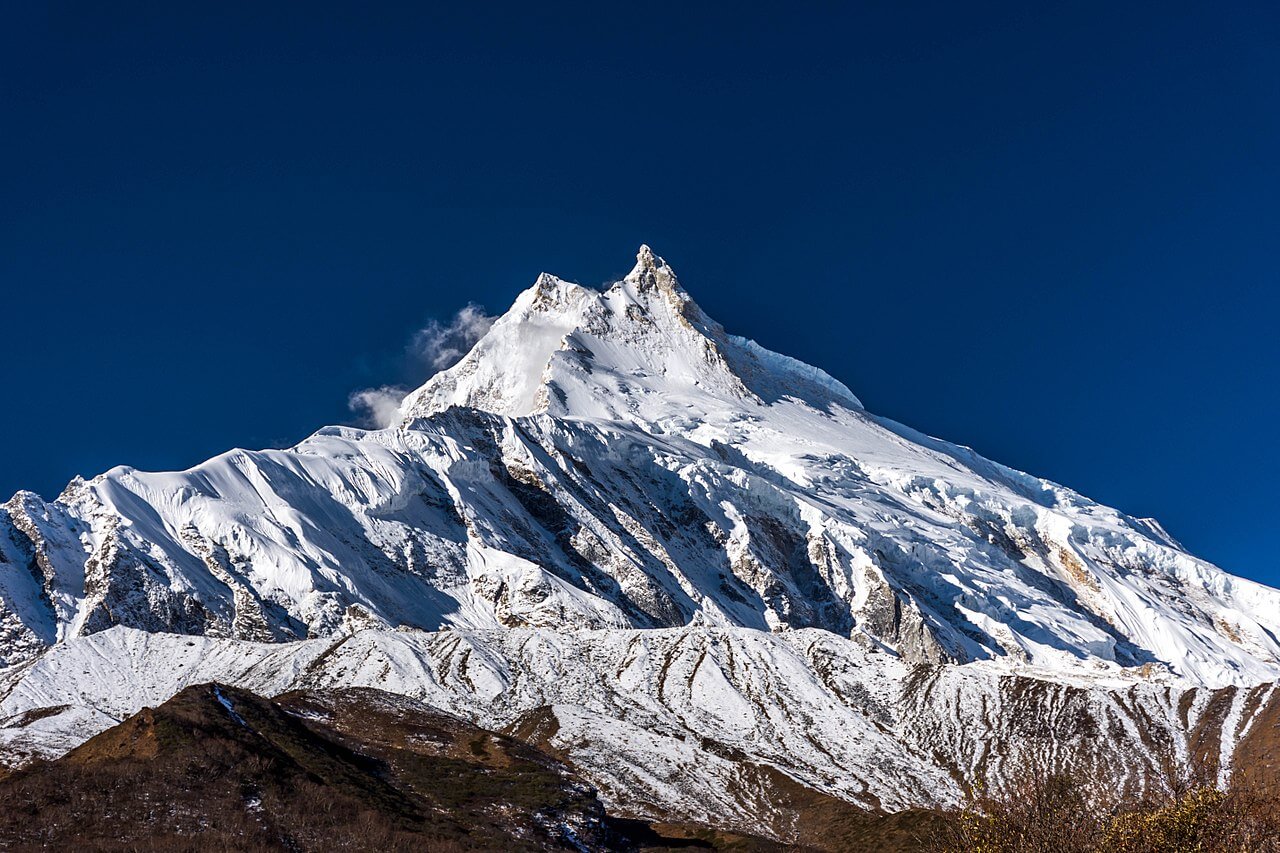
Manaslu Circuit Trek is a wild and remote adventure destination in the high Himalayas of Nepal. This trek is considered to be relatively strenuous and challenging as the trekkers will have to hike through rustic villages, diverse terrains, moraines, and Himalayan passes.
The trek covers approximately 177 km of the total distance. On the standard 18-days itinerary, you’ll have to walk around 10-12 days averaging 15-20 km per day.
This trek also covers massive altitudinal variations, starting from 815m at Soti Khola to 5,135m at Larkya La Pass. The biggest challenge of the entire trek is to cross the Larkya La Pass. Therefore, it is advisable to be cautious regarding the altitude and make sure to know the symptoms of Acute Mountain Sickness (AMS).
The weather in the Himalayas is unpredictable and harsh, especially in the upper reaches of the trek. Although the days are moderately warmer, the temperature drops extensively during the nights. Therefore, it is highly recommended to prepare yourself for the harsh weather. A waterproof hiking boot, decent down jacket, and a proper sleeping bag are highly advisable while trekking in Manaslu.
Physical fitness and mental preparation should be highly considered to take on the challenge of Manaslu. Before committing yourself to the adventure, make sure to train well, and engage yourself in the cardio-related activities as much as possible.
Manaslu Trek Permits
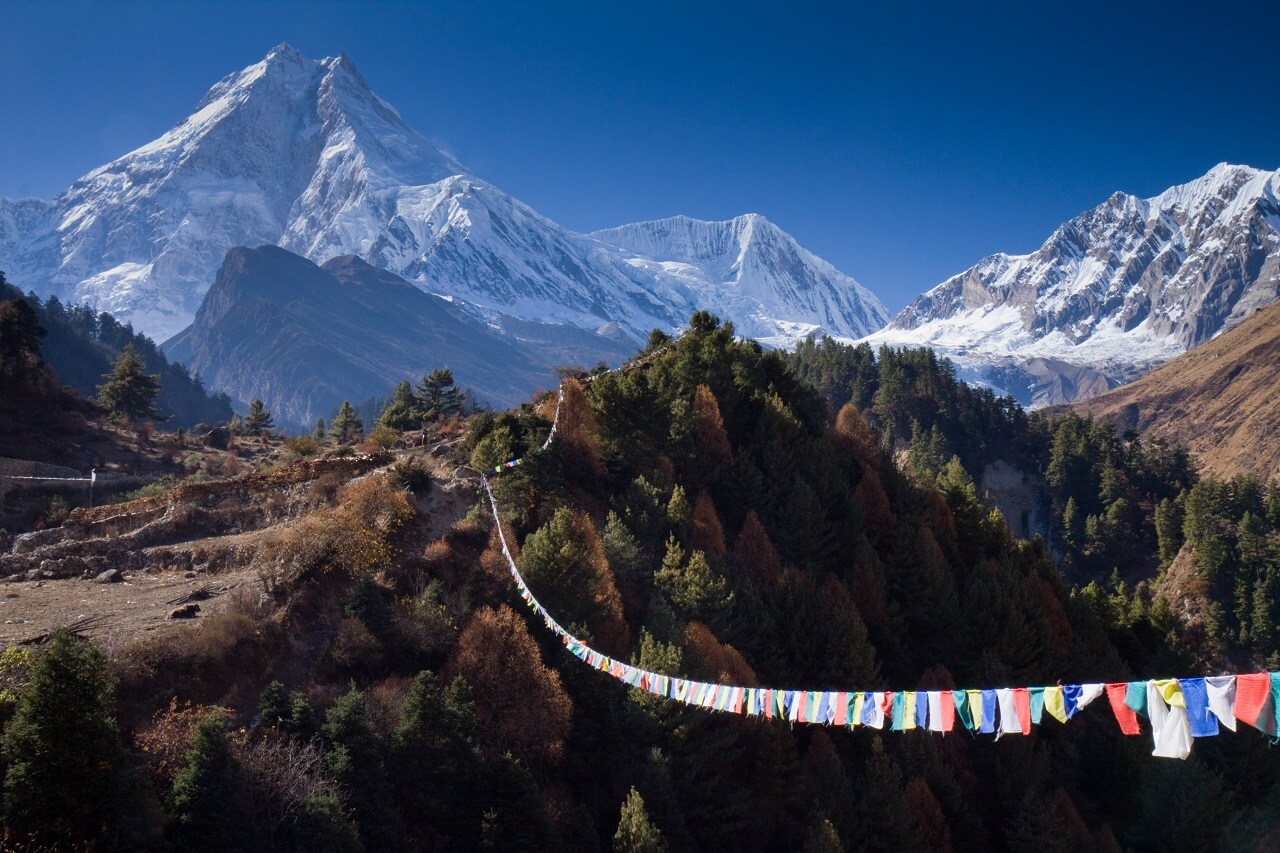
To maintain sustainability, the government of Nepal has declared the Manaslu region as a restricted area applicable from Jagat to Dharapani. So, you need to acquire a special restricted area permit (Manaslu RAP) while trekking to Manaslu. In the Autumn season (September to November), the cost of the special permit for Manaslu is $70 per person for the first week with an additional fee of $10 each day after that. For the rest of the year, the cost drops to $50 for the first week with an additional fee of $7 per day. You do not require a printed photograph for the special permit as the photograph will be uploaded online and printed out with the permit.
You will also need to acquire MCAP (Manaslu Conservation Area Project) Permit as well as ACAP (Annapurna Conservation Area Project) Permit for this trek. Both ACAP and MCAP cost about $27 per person for international trekkers. For SAARC nationals, the cost of both the permits is only $2. The price of these permits remains the same throughout the year. Both these permits require printed photographs.
You can issue the restricted area permit (Manaslu RAP) from the Department of Immigration. You can fill up the permit form online at http://online.nepalimmigration.gov.np/trekking-permit.
You can issue the MCAP and ACAP at following Entry Permit Counters:
- Nepal Tourism Board, Kathmandu – ACAP & MCAP
- Nepal Tourism Board, Damside, Pokhara – ACAP
- ACAP Entry Permit Center, Besisahar, Lamjung – ACAP
Usually, you can not issue the entry permits from any other counters in the trail. However, in exceptional circumstances, other permit counters also grant the licenses with a 100% additional charge.
Additionally, if you choose to extend your Manaslu Circuit Trek with Tsum Valley, you’ll have to issue a separate restricted area permit. It will cost you $40 per person for the first seven days with an extra $7 each after the week during the Autumn. During the rest of the year, the cost drops to $30 per person for the first week with an additional $7 each.
Also, trekking independently is not allowed in the Manaslu region. The government rules state a minimum of 2 trekkers along with a guide/porter is mandatory to do the Manaslu Circuit Trek.
| Required Permits | For SAARC Countries | For International Countries |
|---|---|---|
| Restricted Area Permit (Manaslu RAP) | Sept-Nov: $70 per week with an additional fee of $10 each day after 7 days. Dec-Aug: $50 per week with an additional $7 each day beyond 7 days. | Sept-Nov: $70 per week with an additional fee of $10 each day after 7 days. Dec-Aug: $50 per week with an additional $7 each day beyond 7 days. |
| MCAP (Manaslu Conservation Area Project) | $27 | $10 |
| ACAP (Annapurna Conservation Area Project) | $27 | $10 |
| Tsum Valley Restricted Area Permit | Sept-Nov: $40 per week with an additional fee of $7 per day beyond 7 days. Dec-Aug: $30 per week with an additional $7 each day beyond 7 days. | Sept-Nov: $40 per week with an additional fee of $7 per day beyond 7 days. Dec-Aug: $30 per week with an additional $7 each day beyond 7 days. |
Insurance for the Trek
We recommend you to get travel insurance while trekking in Manaslu Circuit Trek. Unlike most of the trekking routes in Nepal, trekking in Manaslu is quite a challenge and requires serious commitment.
Since this trek is remote and isolated, there are no proper health posts on the trail. If any trekkers get into severe medical conditions, the only way out of this trek is helicopter evacuation.
Make sure to buy individual travel insurance that comprises all the necessary medical costs, helicopter evacuation, trip cancellation charges, theft, and natural disasters. If you’re looking for decent travel insurance, we recommend you to buy it from World Nomads.
Guided vs. Independent Trek
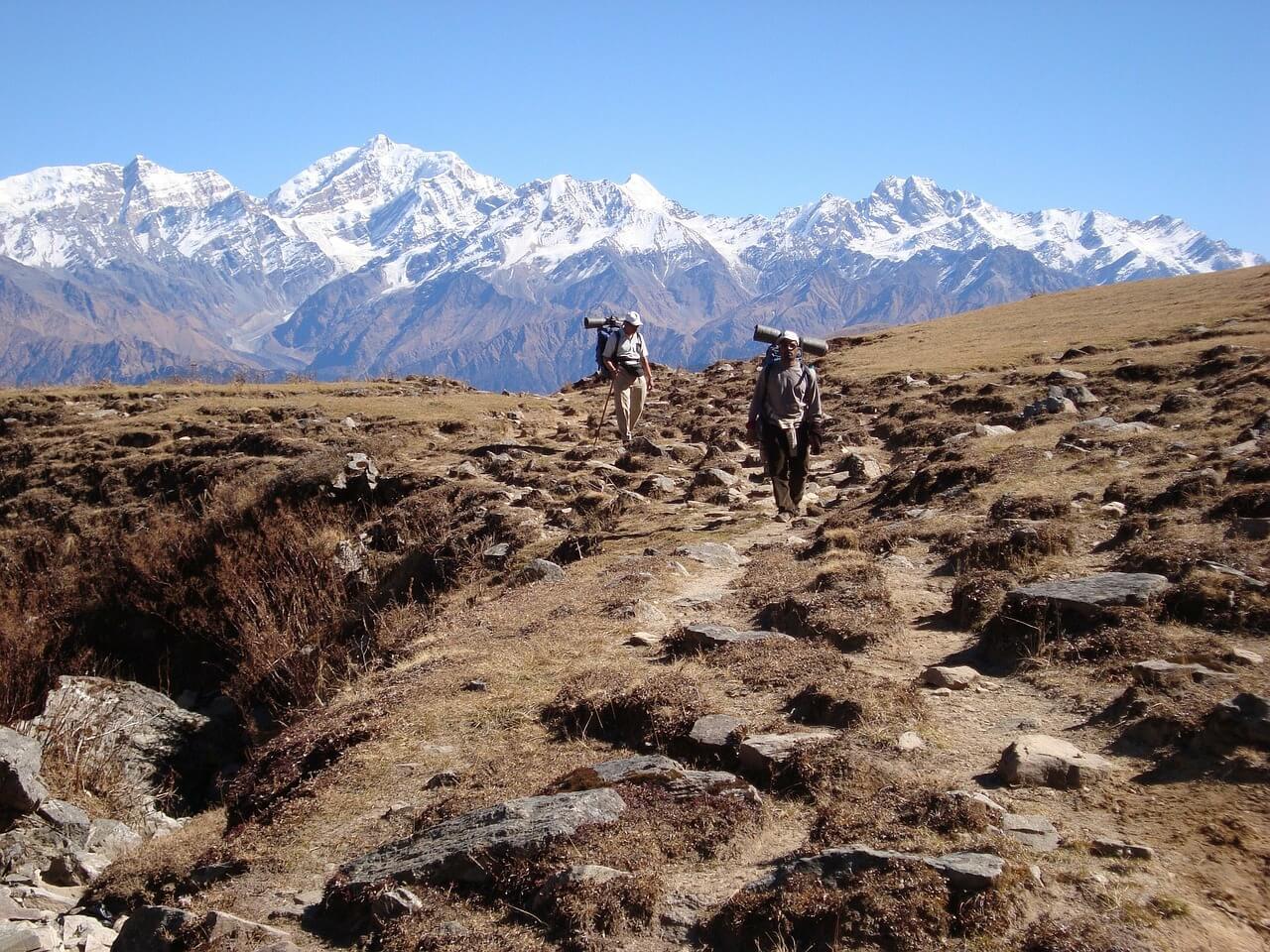
Manaslu Circuit Trek falls under the restricted area, which requires a mandatory trekking staff, either a registered guide or porter cum guide, to trek in this region. The Government of Nepal has declared that any foreign trekkers trekking to the Manaslu region must have a special permit to travel the area.
As per the policies, a minimum of two trekkers with a registered trekking guide is mandatory for this trek. Therefore, trekking independently in Manaslu Circuit is not possible for foreign tourists.
The trail to Manaslu is remote and challenging with very few dedicated trekkers making their way in this region. Additionally, there are a few places, marked landslide-prone zone. Therefore, it is essential to have a guide while trekking in Manaslu Circuit.
However, if you’re willing to go without a guide, the only alternative is to hire a porter cum guide. While hiring a porter-guide may cost you a little cheaper than registered guides, most of them do not speak fluent English.
Accommodation and Food
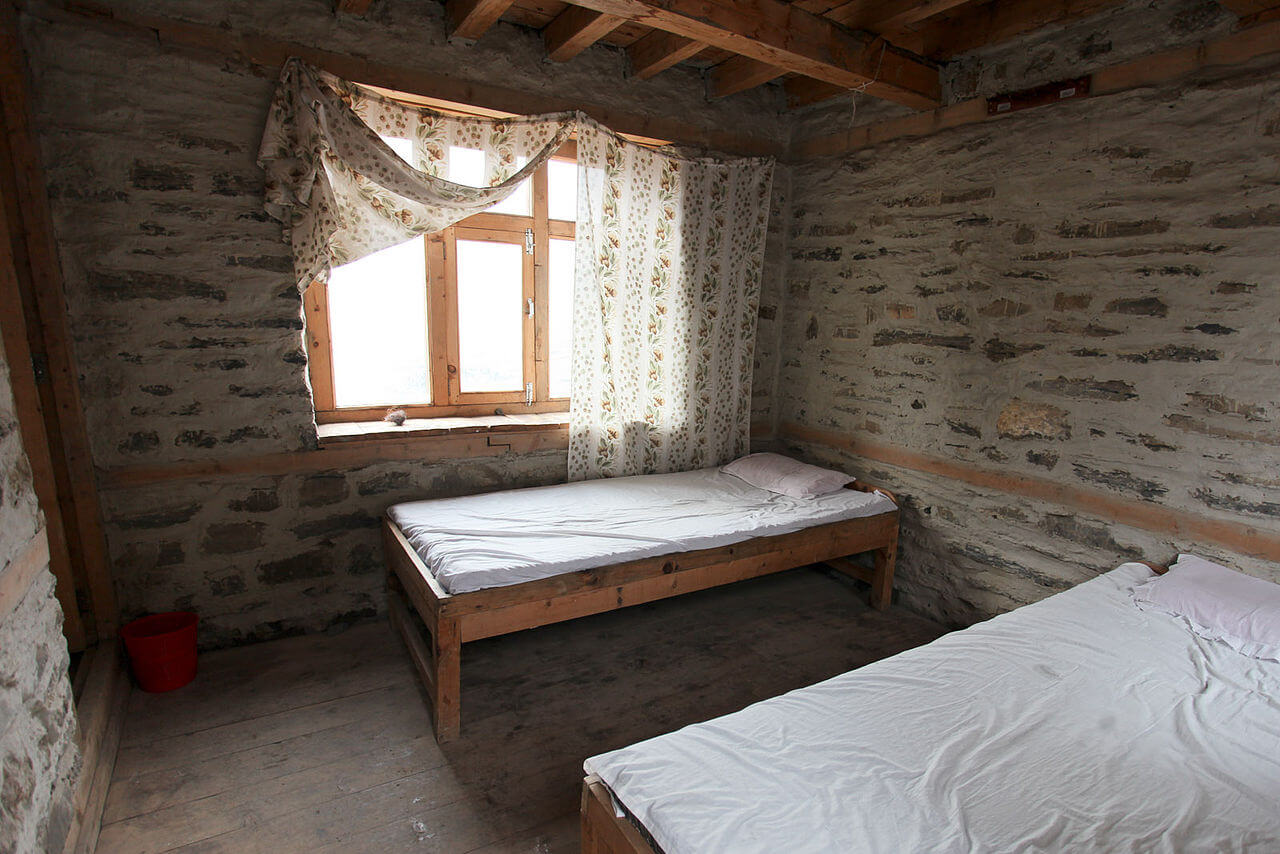
Teahouses and local lodges facilitate the entire trail of Manaslu Circuit, except in Dharmasala. In Dharmasala, you may occasionally have to sleep under a tent. The local communities of the region operate the teahouses and lodges in the Manaslu region.
The rooms are quite basic, with two standard single beds. The toilets are mostly shared and are outside the teahouse at some places. The heating facility is only available in the dining hall.
Unlike Everest and Annapurna treks, there are no luxury hotels in Manaslu. Most of the lodges do provide a hot shower facility; however, you may have to pay extra money for the service.
The teahouses of Manaslu also provide a menu with a variety of western food. The food somewhat costs cheap in the lower reaches of the trek and increases along with the elevation rise. Also, the food choices on the menu will get limited in the higher section of the trek.
Although the menu offers a variety of western foods, Dal Bhat is the most popular food during the trek.
Manaslu Circuit Trek Cost
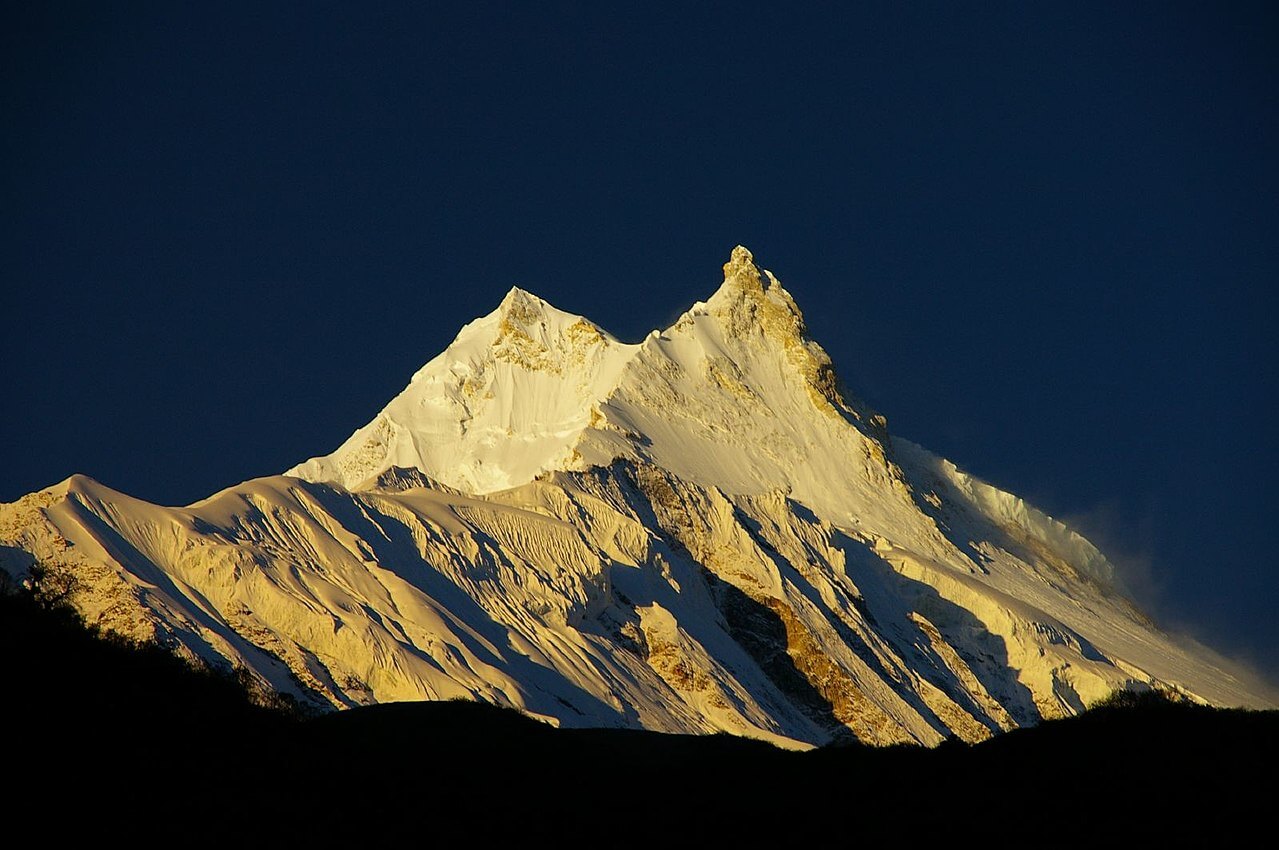
The cost of Manaslu Circuit Trek depends upon various factors such as duration, mode of transportation, lodging, and food. Although this trek is slightly expensive compared to Langtang Valley or Annapurna Base Camp, the remote and untouched beauty of Manaslu is worth every penny.
Since Manaslu trek lies in the restricted zone, you need a restricted area permit to enter the region. The special permission for Manaslu is $70 per person for one week. After the first week, it’ll cost an additional fee of $10 each day during the Autumn. However, the cost drops to $50 with an additional fee of $7 each day for the rest of the year. You’ll also need ACAP and MCAP for Manaslu trek, which will cost you approximately $27 each.
Additionally, if you choose to extend your Manaslu Circuit Trek with Tsum Valley, you’ll have to get a separate restricted area permit. The charge of Tsum Valley permits costs $40 per person for the first seven days with an extra $7 each after the week during the Autumn. For the rest of the year, the cost drops to $30 per person for the week with an additional $7 each day.
The teahouses are relatively cheap in Manaslu, costing you as little as $6 to $9 per night with an additional $5 per meal. The local buses to Soti Khola from Kathmandu costs you about $10 per person. However, traveling by jeep is more expensive, costing you roughly $150 to $200 per person.
Since Manaslu Circuit Trek lies in the restricted area, it is mandatory to have a licensed guide or a porter on the trek. A licensed guide will cost you about $20 to $25 per day while porters cost you about $15 to $20 per day. You can hire a porter-guide which will cost you $18 to $22 per day.
| Services | Cost |
|---|---|
| Manaslu Restricted Area Permit | September-November $70 per person/ week $10 per person/ week (after 1 week) December-August $50 per person/ week $7 per person/ week (after 1 week) |
| ACAP | $27 |
| MCAP | $27 |
| Tsum Valley Special Permit | September-November $40 per person/ week $7 per person/ week (after 1 week) December-August $30 per person/ week $7 per person/ week (after 1 week) |
| Teahouses | $6 - $9 per night |
| Meals | $5 per meal |
| Local Bus | $10 |
| Jeep | $150 - $200 |
| Trekking Guide | $20 -$25 per day |
| Porter | $15-$20 per day |
| Porter Cum Guide | $18-$22 per day |
Packing List for Manaslu Trek
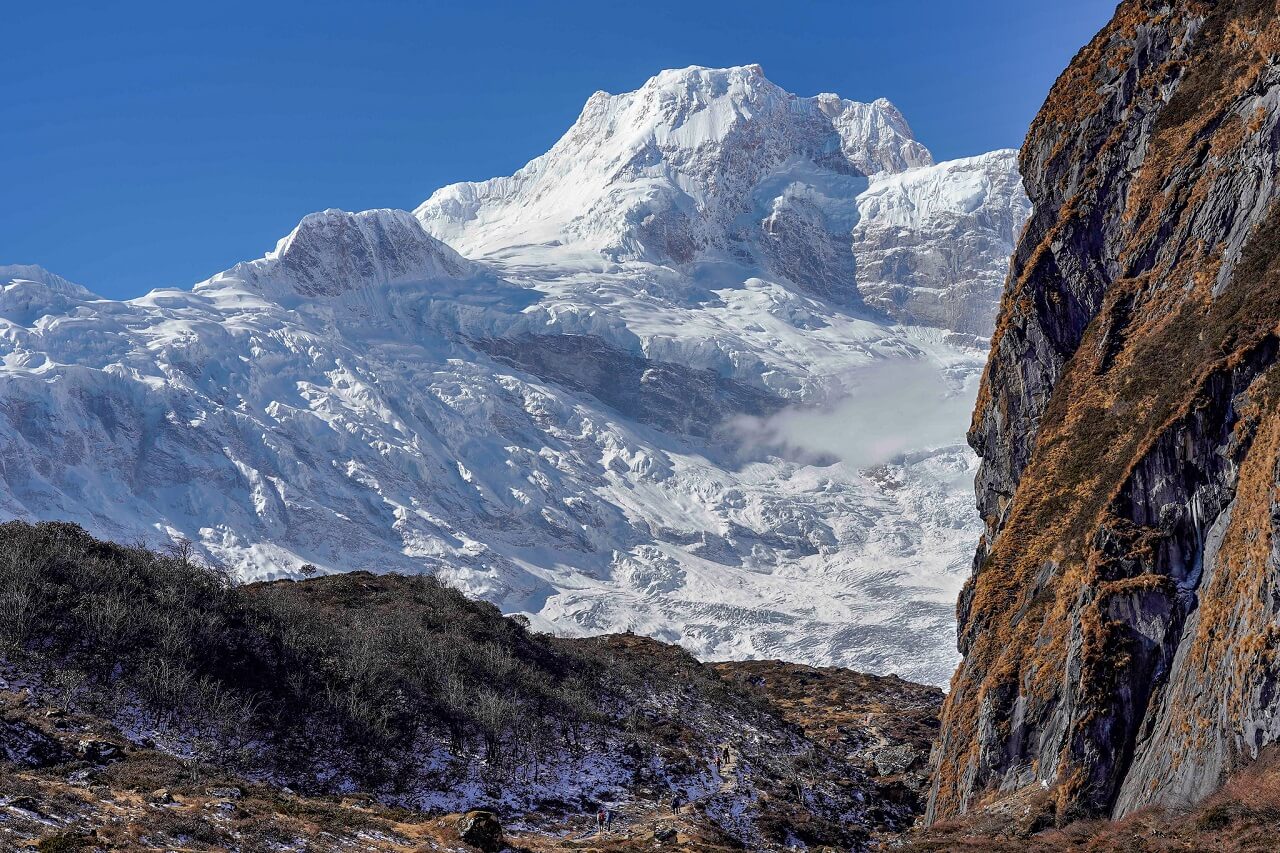
If you’re planning to experience the thrill of trekking to the remote and inaccessible areas of Manaslu, make sure you’re carrying the right equipment. While it is quite a dilemma when it comes to what to pack for the trek, it matters how and when you’re planning to travel.
Since Manaslu does not permit the individual travelers, you’ll have to hire a porter. The porter will carry the substantial portion of the weight, leaving you with the daypack. Hiring a porter does not mean you should be packing everything you can think of for the trek. Although you’ll have someone to help you with the luggage, make sure to pack your bags with right gears.
Here are some of the essential gears you need to pack while trekking to Manaslu Circuit:
Bags:
- Duffel Bags
- Daypack
Clothing:
- Trekking Shirt: 5-7 shirts, make sure to balance both long and short.
- Trekking Trousers: We recommend you to pack at least 2 trekking trousers along with a couple of shorts.
- Base Layer: Make sure to pack a couple of wool base layers to keep yourself warm in the upper reaches of the trek.
- Insulation Layer: A decent quality of fleece jacket will do!
- Outer Layer: Warm down jacket that will mainly be used in the higher altitudes when the weather gets extreme.
- Waterproof Shell Jacket: Pack a pair of waterproof jackets as you may encounter rain in the trail.
- Breathable Underwear: We recommend you to carry 5-6 pairs of moisture-wicking underwear.
Footwears:
- Hiking Boots: Invest in high-quality waterproof hiking boots. Make sure the boot is lightweight and comfortable.
- Trainers/Sandals: It is handy to carry a pair of either trainers or sandals to wear them in the teahouses.
- Hiking Socks: You should carry 4-6 pairs of hiking socks. Any brand or label works as long as they are breathable and moisture-wicking. Do not bring cotton socks as they soak easily and may lead to blisters.
- Thermal Socks: We recommend you to pack at least a pair of thermal socks to keep your feet protected from the cold in the higher altitudes.
Head Wears:
- Sun Protection Hat: It is mandatory to carry a protection hat to keep your face protected from the harsh sun.
- Beanie: An absolute must to keep yourself warm, especially during the evening and night.
- Buff/Neck Gaiter: This small piece of gear comes in handy to protect your neck from the cold winds and also helps you stay protected from the dust.
Hand Wear:
- Inner Gloves: Pack light inner gloves as they can be useful when the temperature is moderate.
- Outer Gloves: You’ll be wearing them in the upper reaches of the trek. Outer gloves need to be insulated, warm, and waterproof.
Sleeping Bags:
Sleeping bags are hands down one of the most crucial gears when it comes to trekking in Manaslu region. With basic rooms and sleeping facilities, you can never rely on the teahouses for warm, decent blankets.
In the lower altitudes, this may not seem much of a problem, but once you get above 3,000m, the temperature even inside the teahouses can get cold.
Therefore, investing in a high-quality, 4-season sleeping bag is an absolute must! If you’re not willing to any chances, buy a sleeping bag that has the minimum rating of -10 degrees Celsius.
Important Accessories:
- Trekking Poles
- Water Bottle
- Basic Medical Kits
- UV Protection Sunglasses
- Headlamp
- Water Purification Tablets
- Hand Sanitizers
- Sunscreen/Lip Balm
- Toiletries
- Trekking Towels
- Camera
- Portable Chargers
Network Information
If you’re willing to stay connected with your family and friends, we suggest you use CDMA networks over any other service providers in the region. Although NTC and Ncell are the two major telecommunication service providers in the country, they barely come to work while trekking to Manaslu.
One thing you should know beforehand with CDMA networks is that they do not work with every other mobile phone. Therefore, you should buy a phone in Kathmandu to make the most out of their service. The CDMA phones are available in nearly all the mobile shops in the city, and they come quite cheap.
Useful Tips
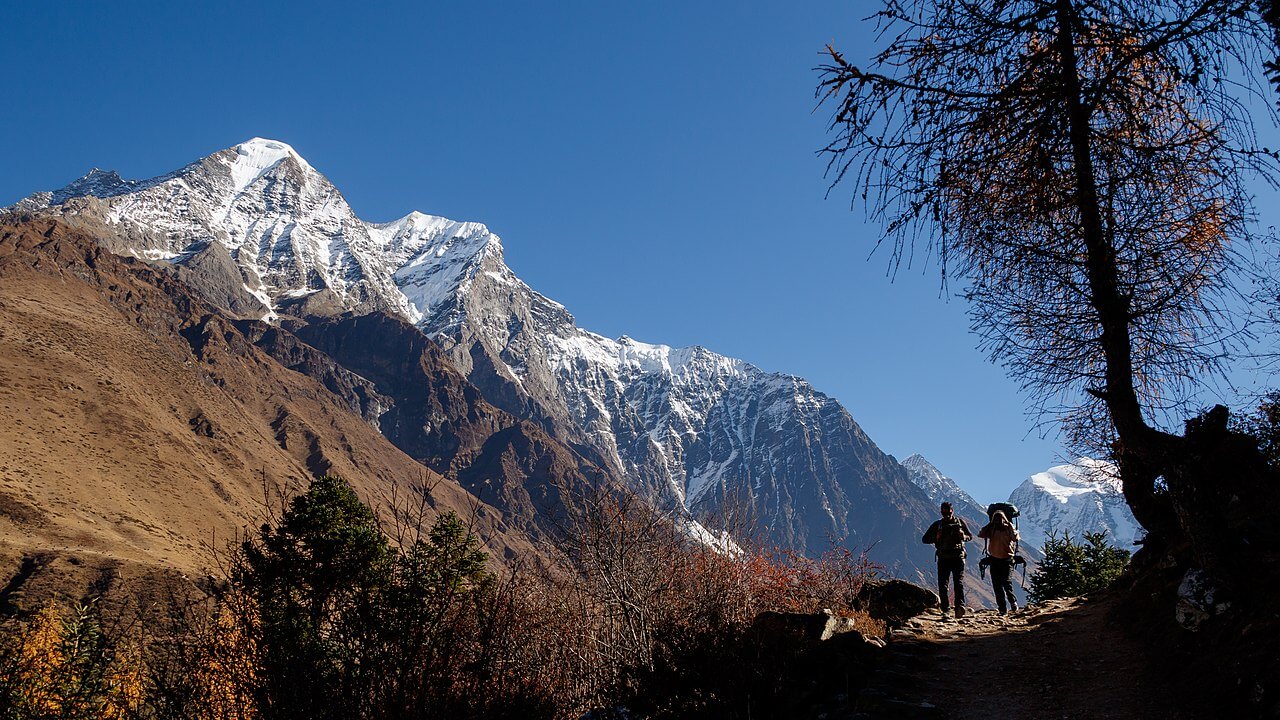
- Manaslu Circuit is one of the most remote and strenuous treks in Nepal. Please make sure to prepare yourself both physically as well as mentally before heading off to the wild.
- Altitude is a constant threat. As the highest elevation point of the trek is whooping 5,135m, it is essential to acclimatize well, take the necessary precautions, and stay hydrated throughout the trail.
- The trails in the Manaslu region are not appropriately marked. Be aware of the route. Always walk with a guide/porter and do not wander off alone in the trail.
- There are several landslide-prone areas in the region. Be careful and watch out for the rocks!
- The trail can be slightly risky when wet and snowy. Therefore, invest in high-quality hiking boots and make sure to pack well for the trek.
- Drinking water may not be safe to drink. A water purifier will be great to have.
- Not all tea houses provide charging facilities. Carrying a portable charger would be handy.
Accommodation in Kathmandu
Thamel is the major tourist hub of Kathmandu. Surrounded by hotels, travel agencies, shops, and restaurants, here you can find accommodations for any budget from cheap hotels to luxury hotels.
However, there are plenty of places outside Thamel where you can find decent hotels in Kathmandu. Some of the accommodation options in Kathmandu are:
| Budget Hotels | Mid-Range Hotels | Luxury Hotels |
|---|---|---|
| WanderThirst Hostel | Nepal Cottage Resort | Dwarikas Hotel |
| Andes House | The Fern Residency | Hyatt Regency |
| Hotel Trekkers Home | Hotel Vaishali | Kathmandu Guest House by KGH Group |
| Zen Bed and Breakfast | Shambaling Boutique Hotel | Hotel Shanker |
| Mitra Garden Inn | DOM Himalaya Hotel | Hotel Yak & Yeti |
Recommended Travel Agencies for Manaslu Circuit Trek
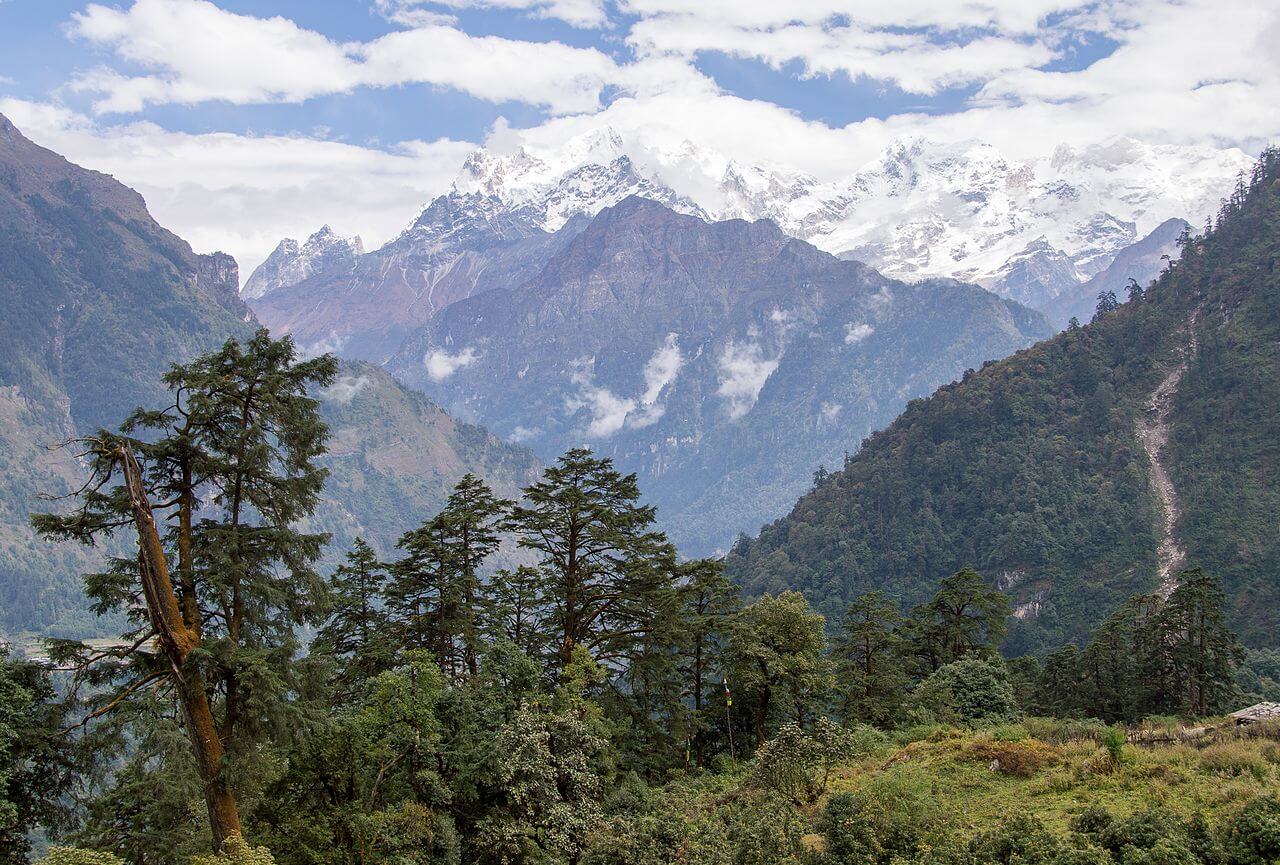
There are thousands of trekking companies that operate the Manaslu Circuit Trek in Nepal. Make sure you’re traveling with an authorized trekking company while trekking in Nepal.
While trekking in the remote and challenging trail of Manaslu Circuit, it is essential to book the trip with an experienced company that ensures breathtaking experience while concerning the clients’ safety.
Some of the best trekking companies in Nepal for Manaslu Circuit Trek are:
Recommended Books and Guidebooks
- Manaslu: A Trekker’s Guide
- Lonely Planet Nepal (Travel Guide)
- The Rough Guide to Nepal
- Birds of Nepal
- The Climb: Tragic Ambitions on Everest
- Into Thin Air: A Personal Account of the Mount Everest Disaster
- High Adventure
- The Snow Leopard
FAQs
1. Is Manaslu Circuit Trek doable?
Although Manaslu Circuit Trek is strenuous and challenging trekking routes in Nepal, this trek is entirely doable. However, you have to maintain a certain level of physical fitness to do this trek. Be aware! Since this is a high altitude trek, you’re also at risk of suffering from Acute Mountain Sickness (AMS).
2. Can I do the Manaslu Circuit Trek solo/independently?
No, the government of Nepal does not permit solo or independent trek in the Manaslu region. As per the government’s rules, it is mandatory to have a minimum of two trekkers accompanied by either a guide or a porter to trek in the Manaslu region.
3. What is the standard of accommodation in Manaslu?
The teahouses and lodges in Manaslu Circuit are basic with two single beds and no heating facilities. The toilets are standard and on sharing basis throughout the trail. Most of the tea houses provide a hot shower but will charge you extra bucks for it.
On the upper reaches of the trek, the accommodations might get draughty and dark. Therefore, we recommend you bring a sleeping bag and a headlamp for this trek. Teahouses are available throughout the trek with the only exception in Dharmasala. At Dharmasala, you may have to spend the night in a tent.
4. Is it safe to drink water in the trek?
No, the water in teahouses is mostly from tap or streams, which is not safe to drink directly. Bottled water is also available throughout the trail. However, the bottled water is slightly expensive and adds more trash on the trail. Therefore, we highly recommend you to carry a water purifier or tablets.
5. Do I need travel insurance before trekking to Manaslu?
Yes, travel insurance is highly advisable while trekking in Manaslu. Since Manaslu is a remote and isolated trek, we suggest you have specific travel insurance for this trek. Make sure your travel insurance covers the cost of necessary medical facilities, theft, natural disasters as well as helicopter evacuations.
Conclusion
Manaslu Circuit Trek is an excellent alternative to the commercial trekking routes like Annapurna and Everest Base Camp. Tucked in the remote region in the Himalayas of Nepal, Manaslu is a sanctuary for adventure enthusiasts and avid trekkers.
As this is one of the most demanding treks of Nepal, this trek demands a serious commitment and physical fitness.
